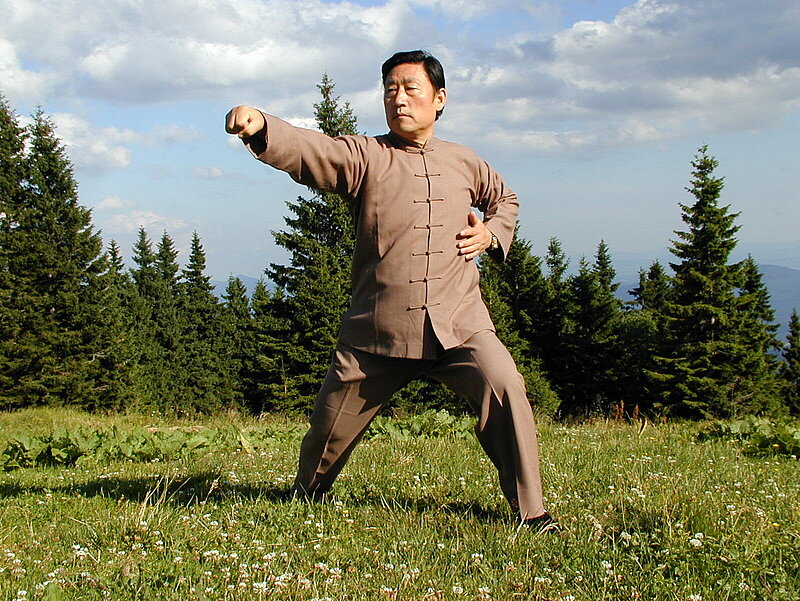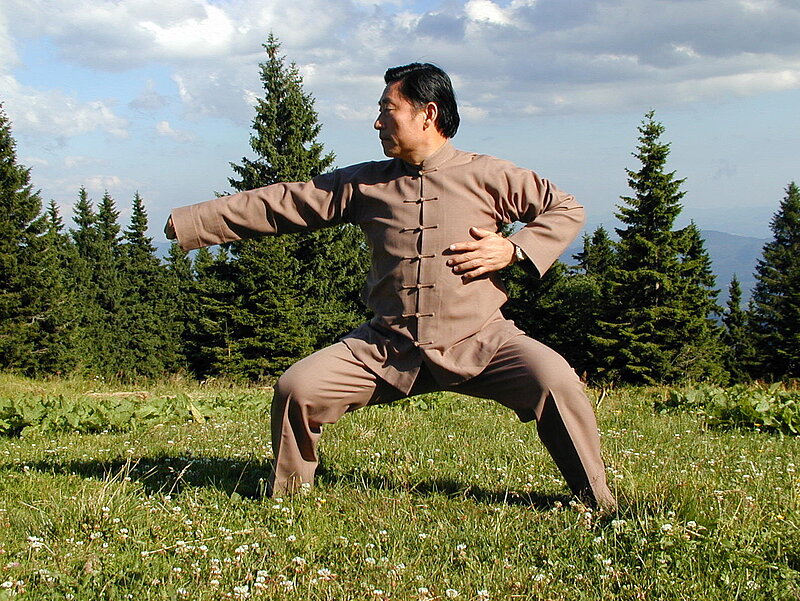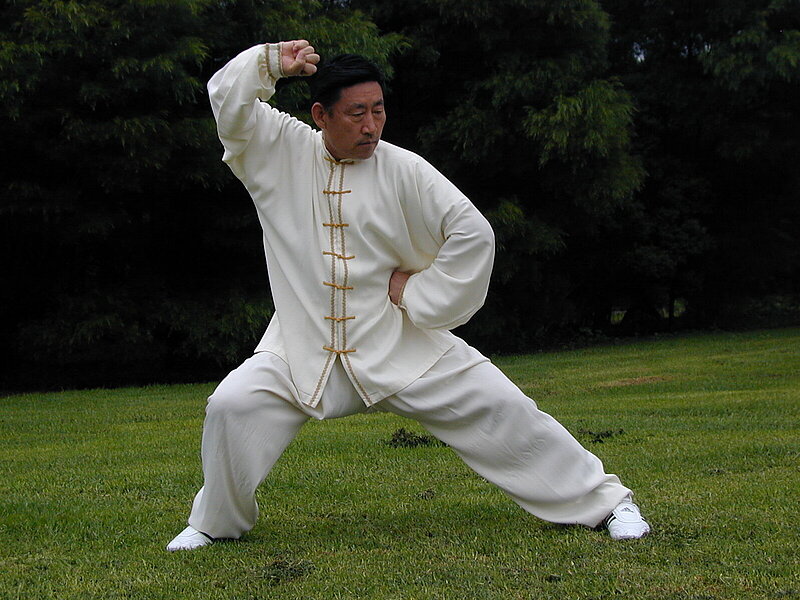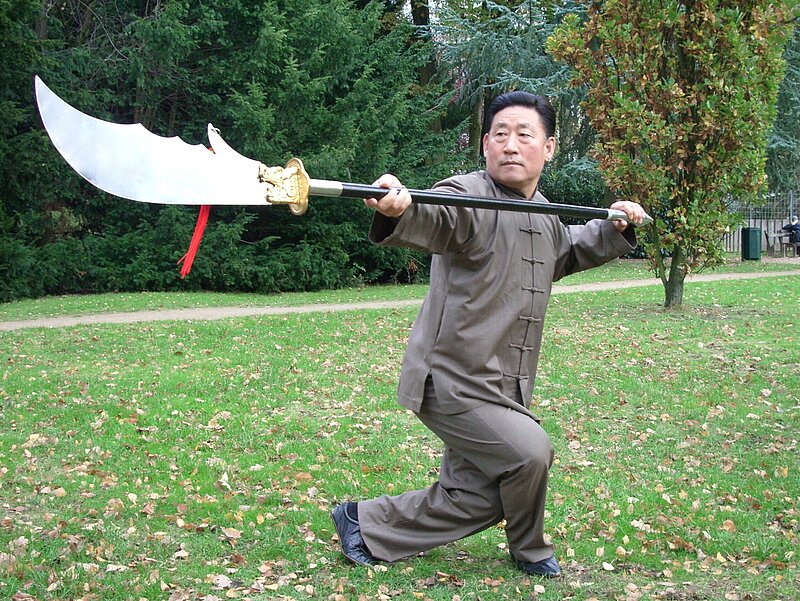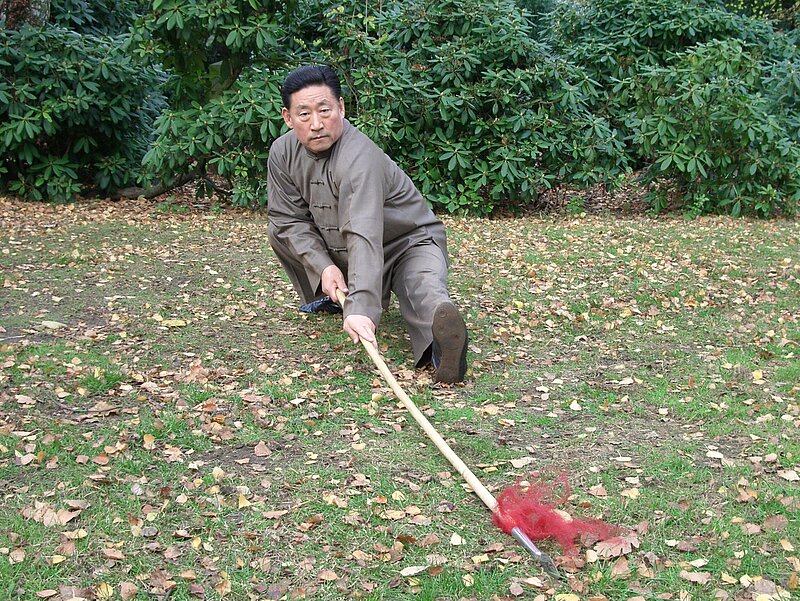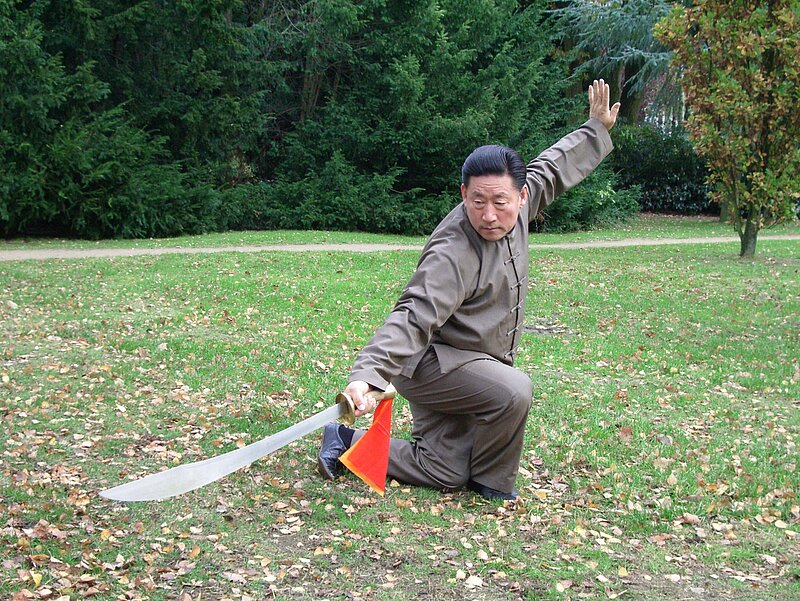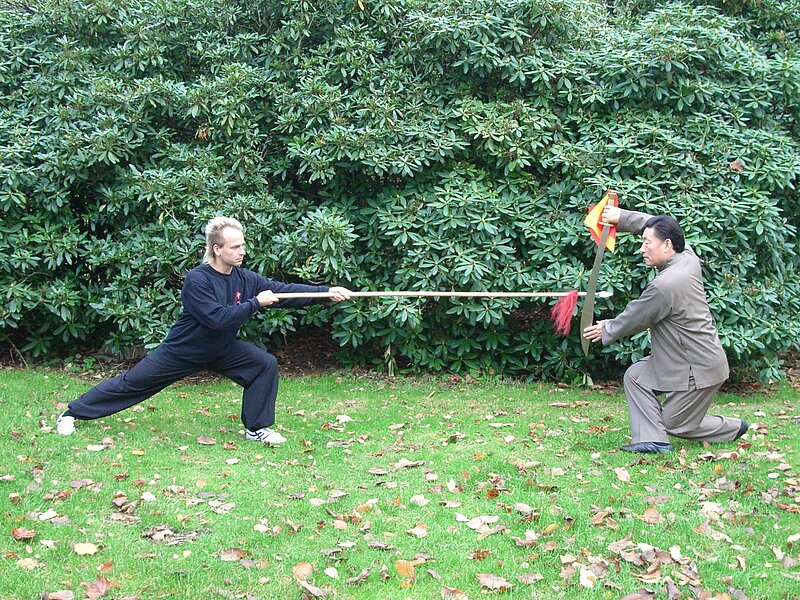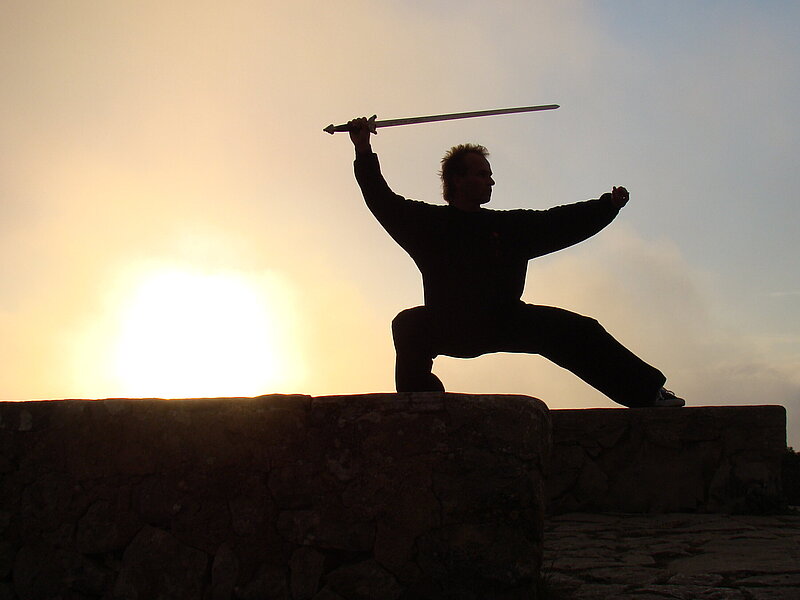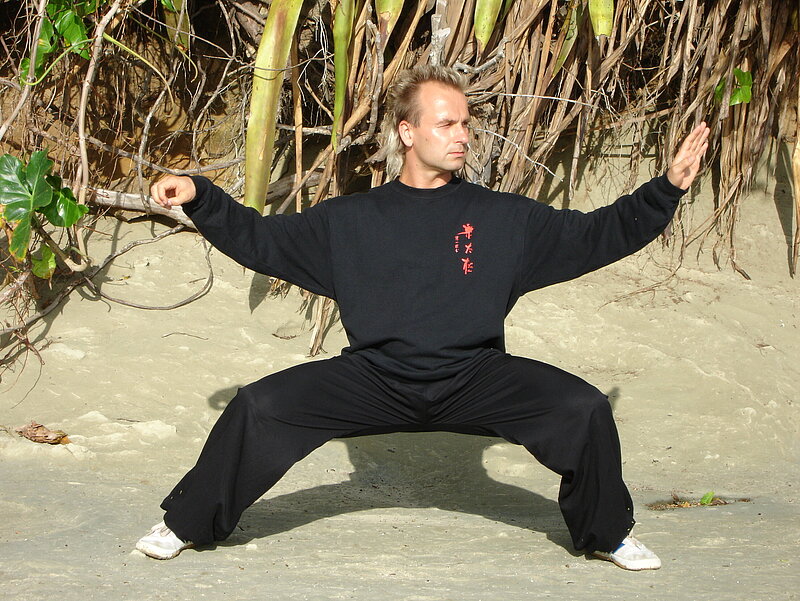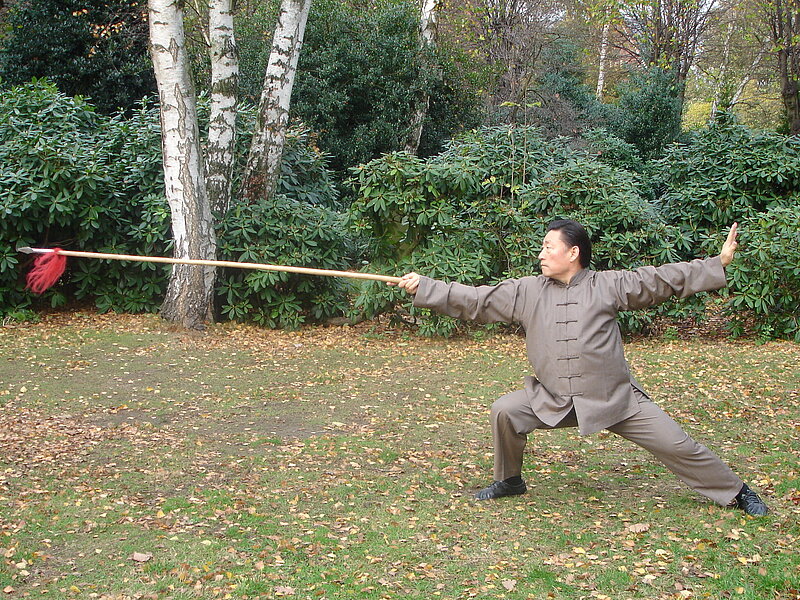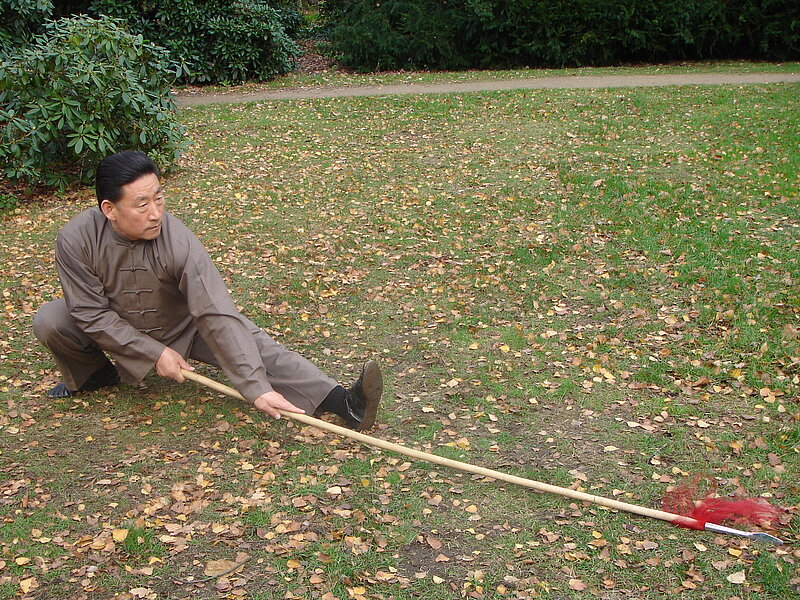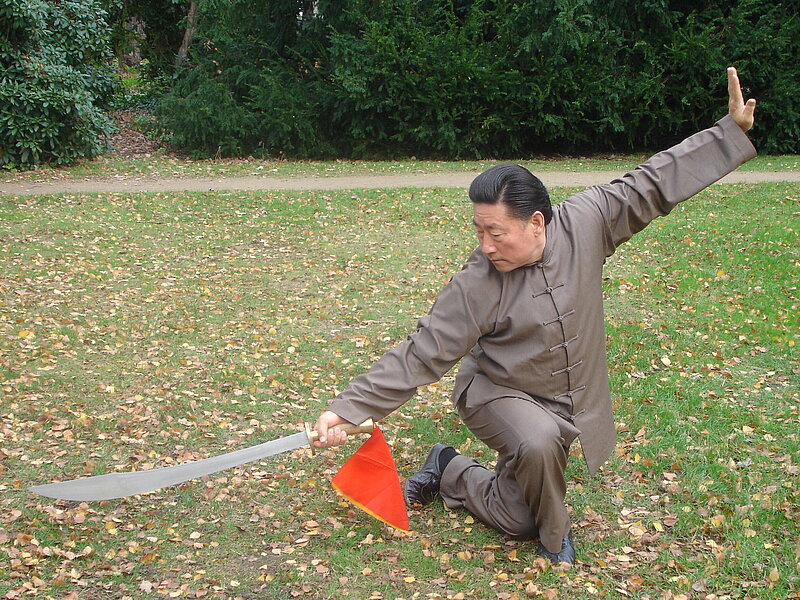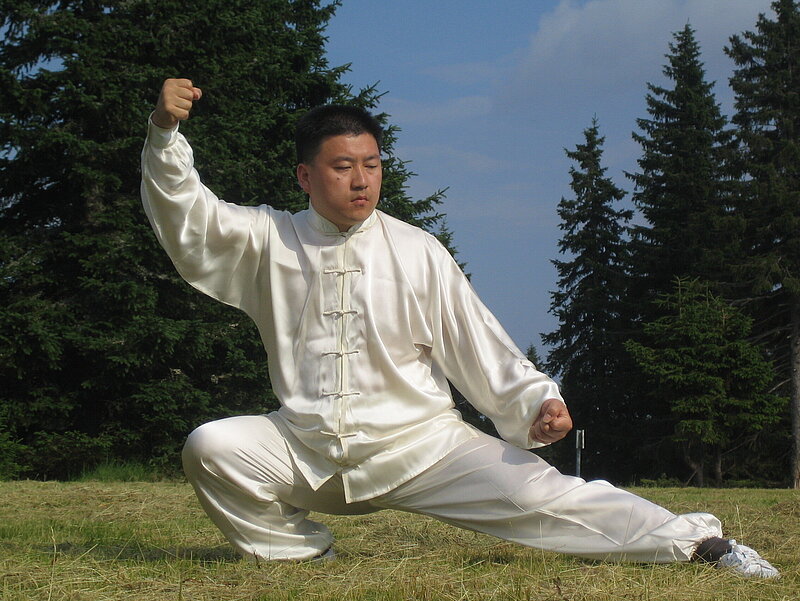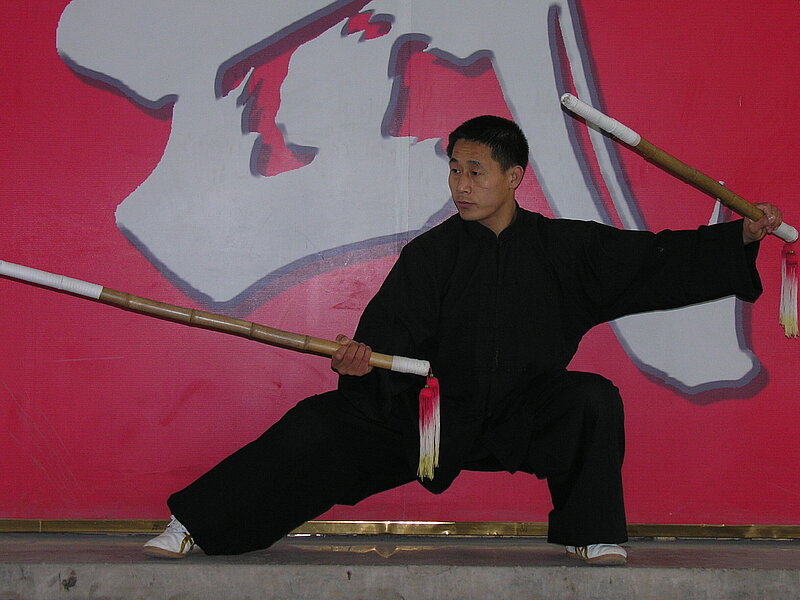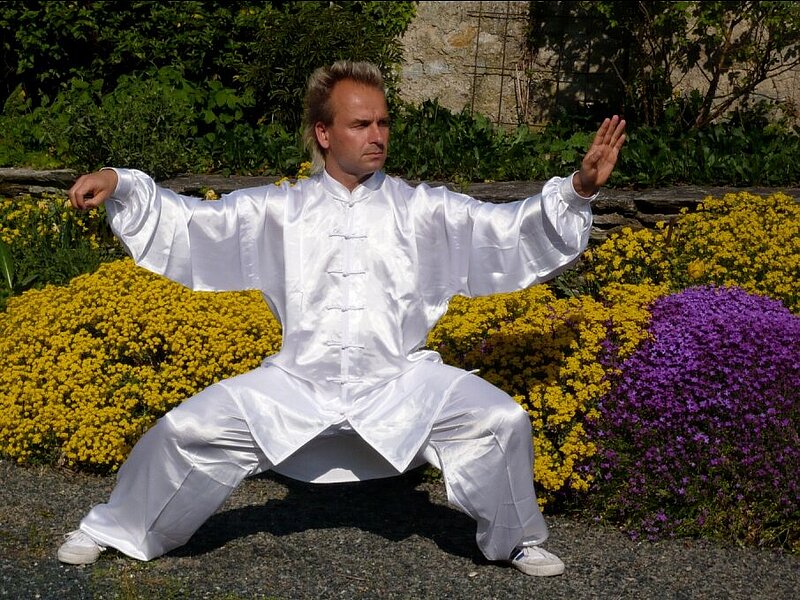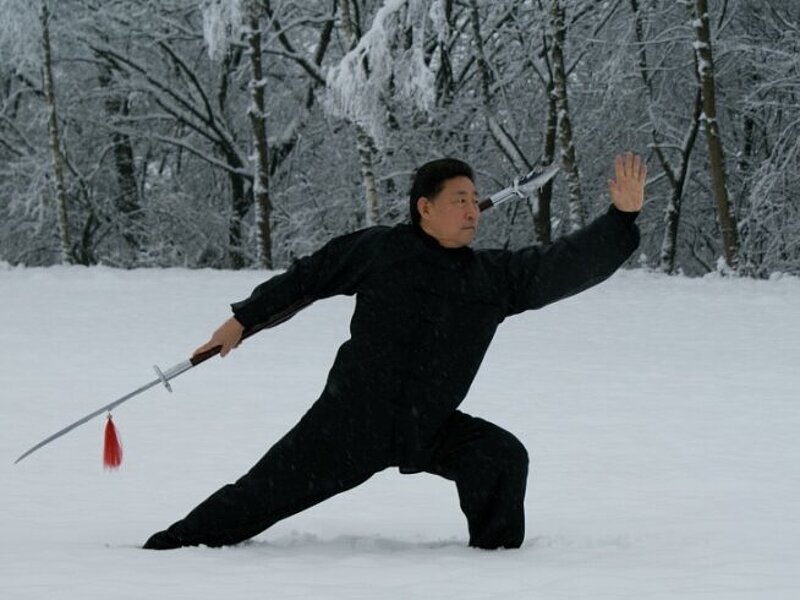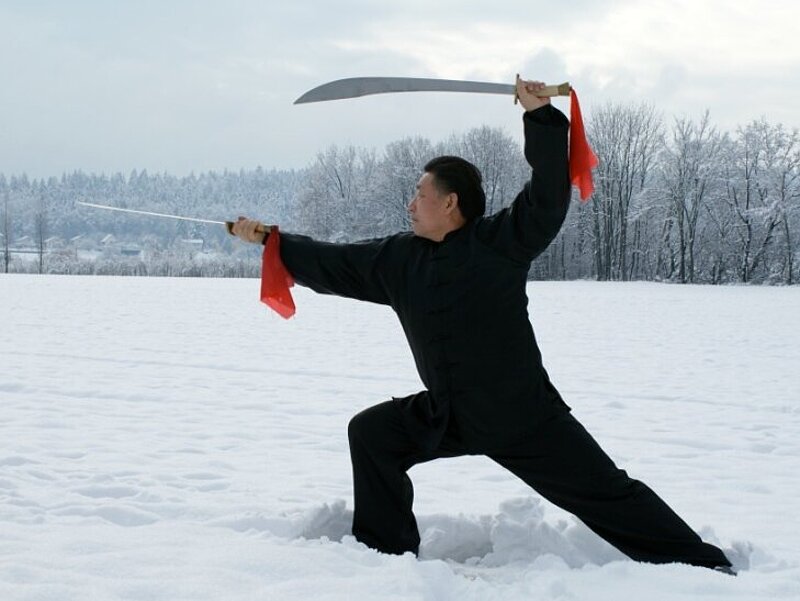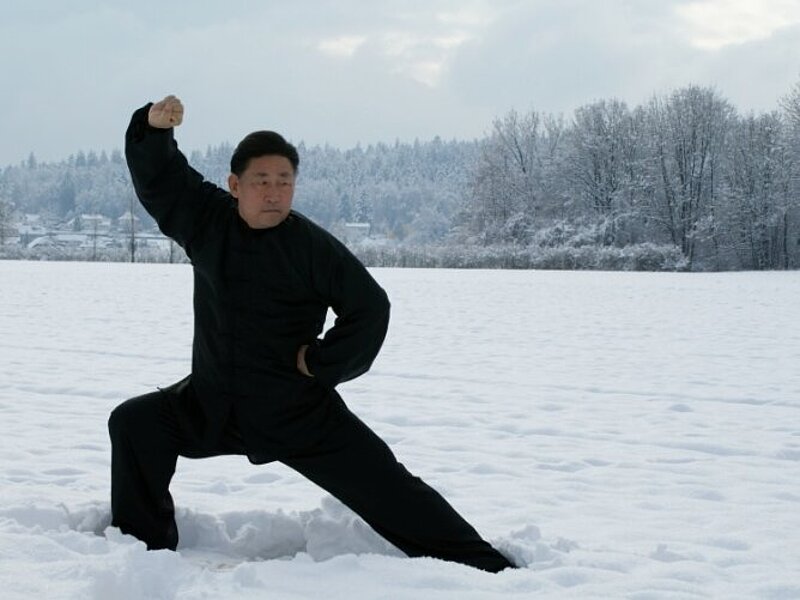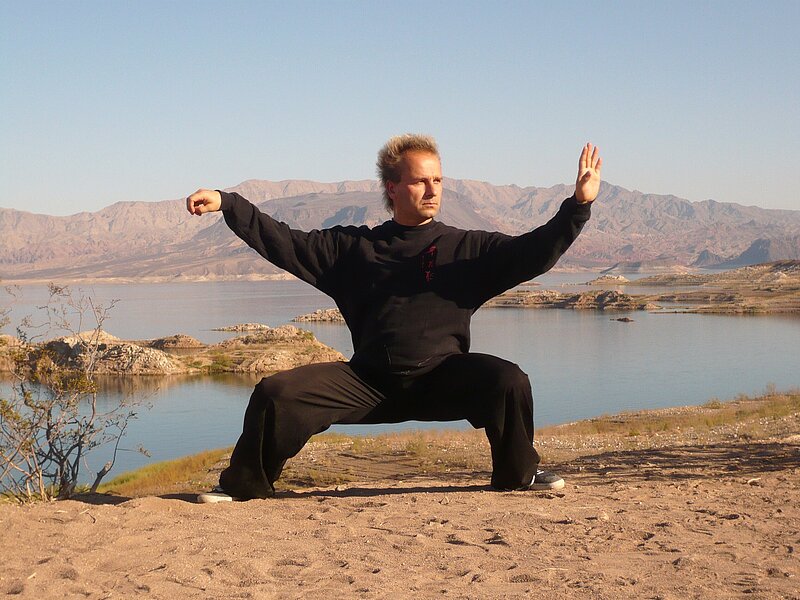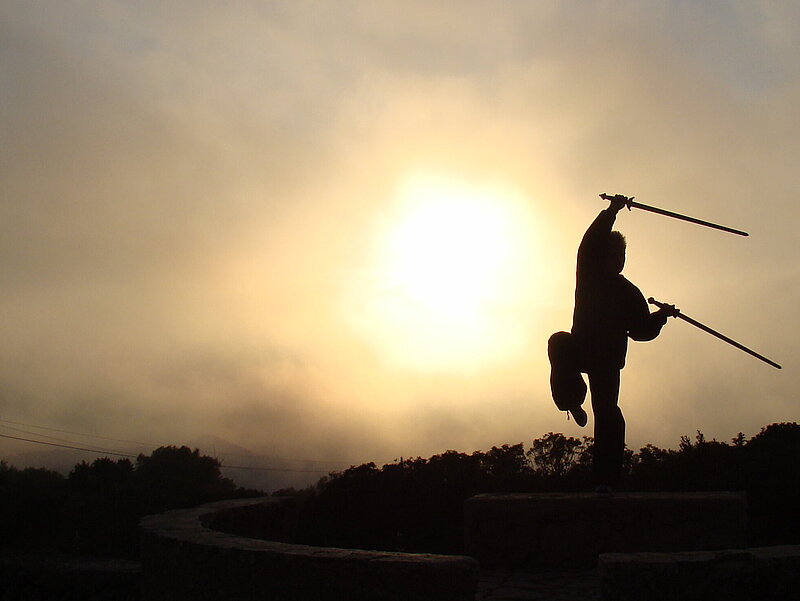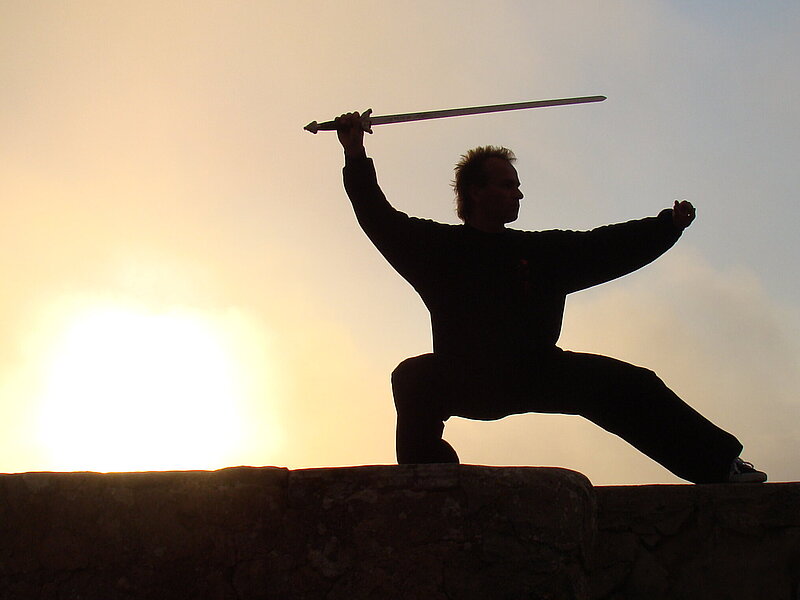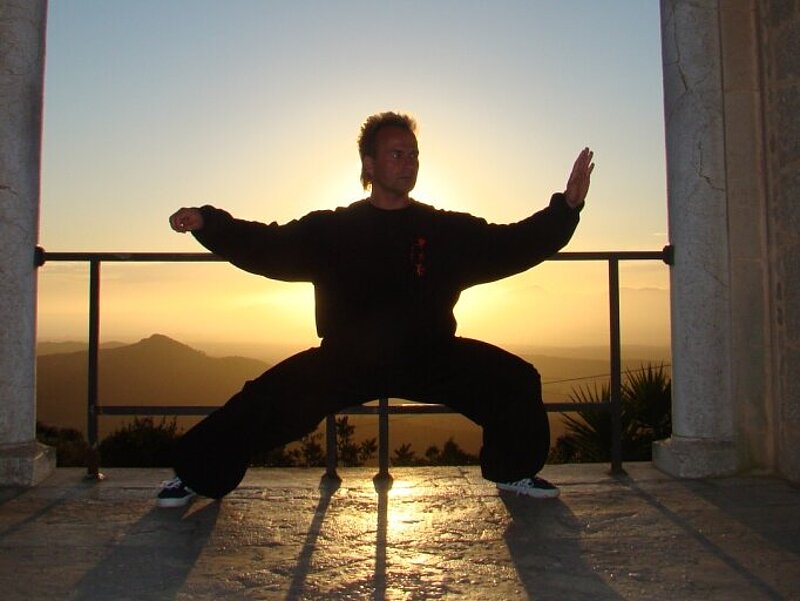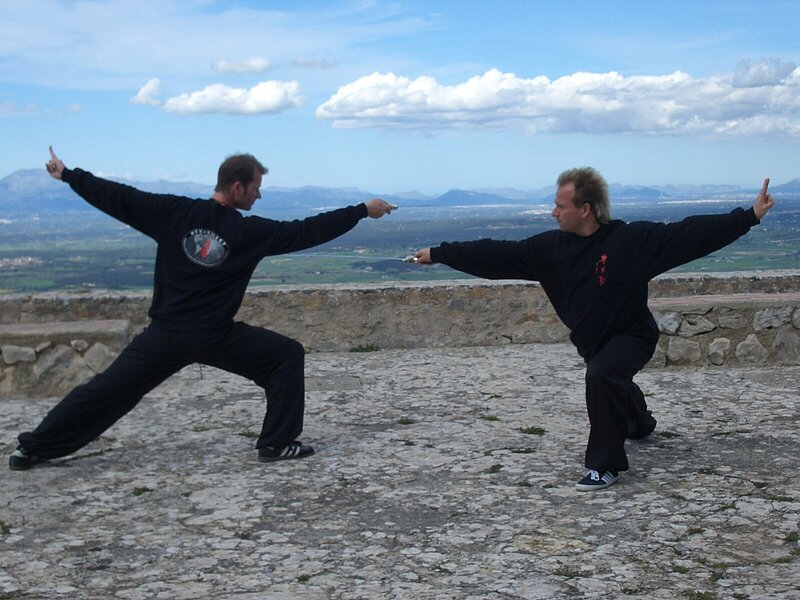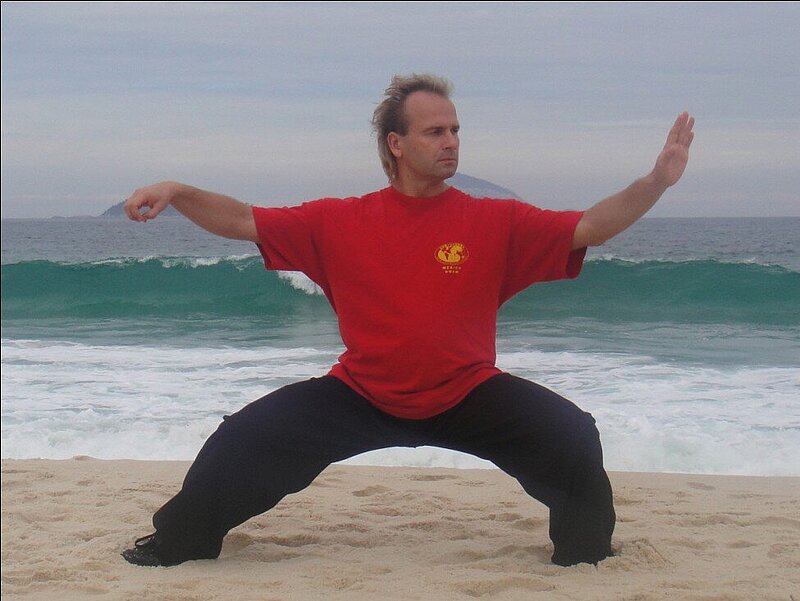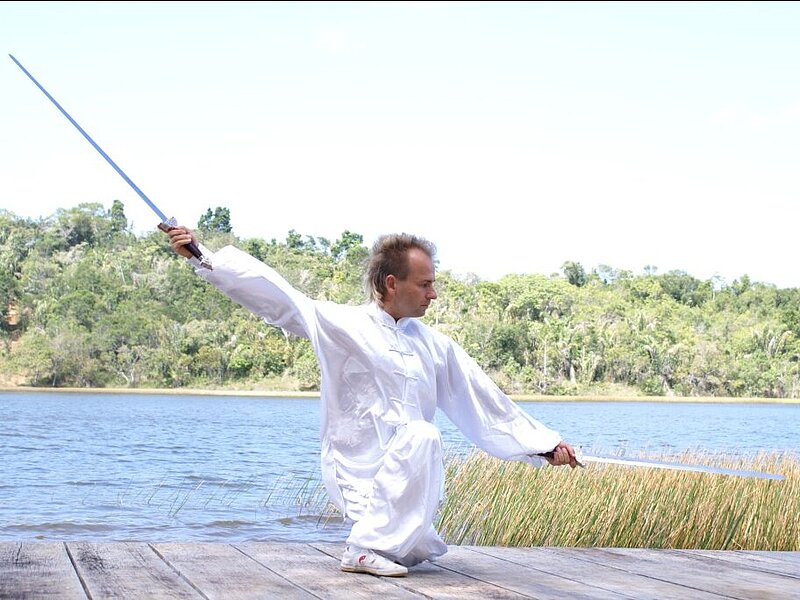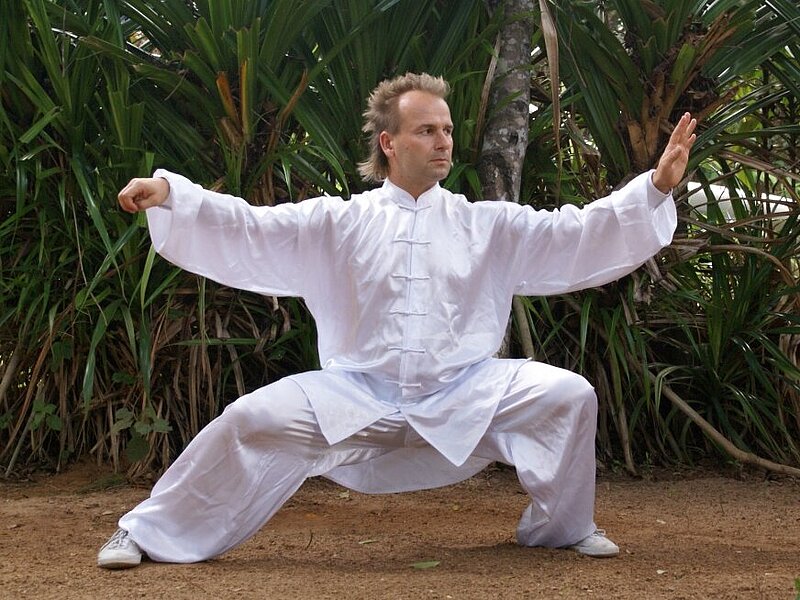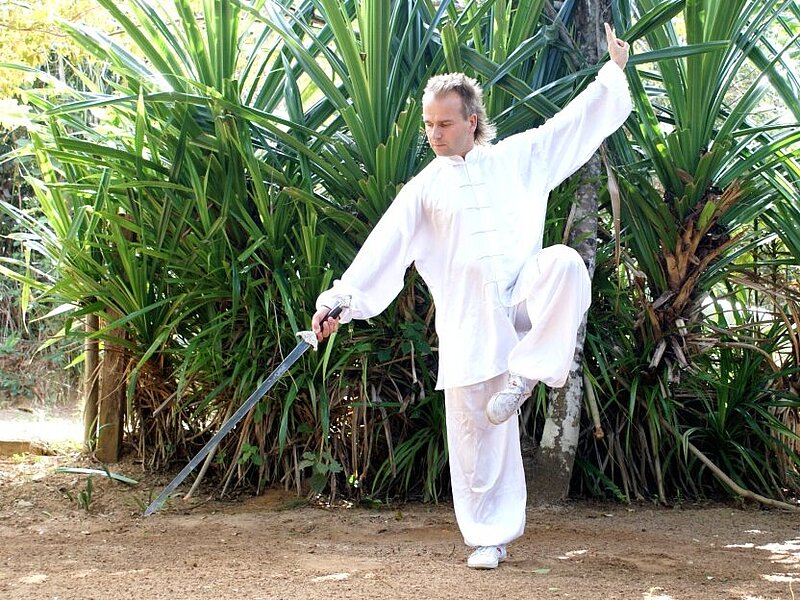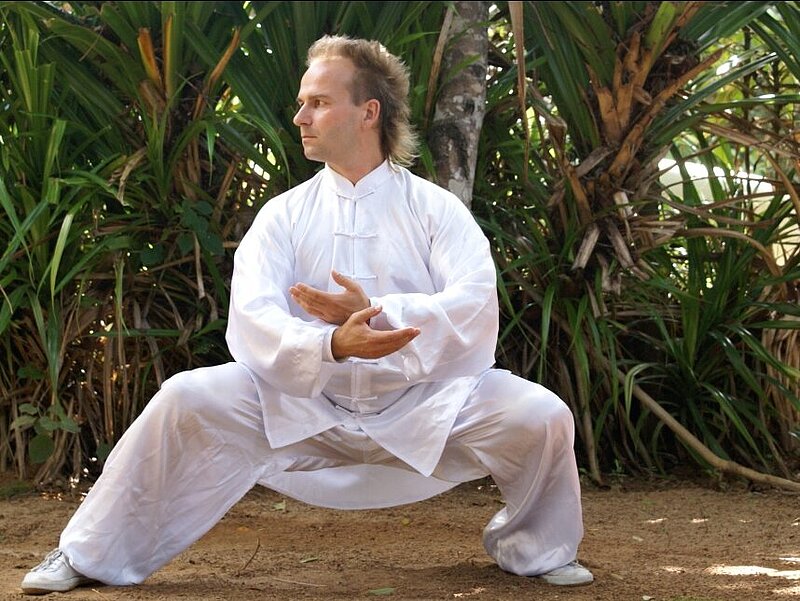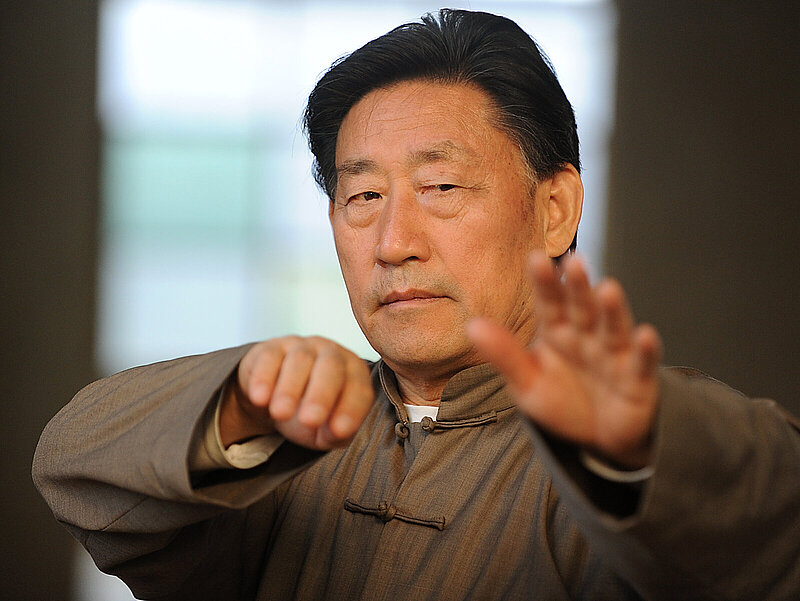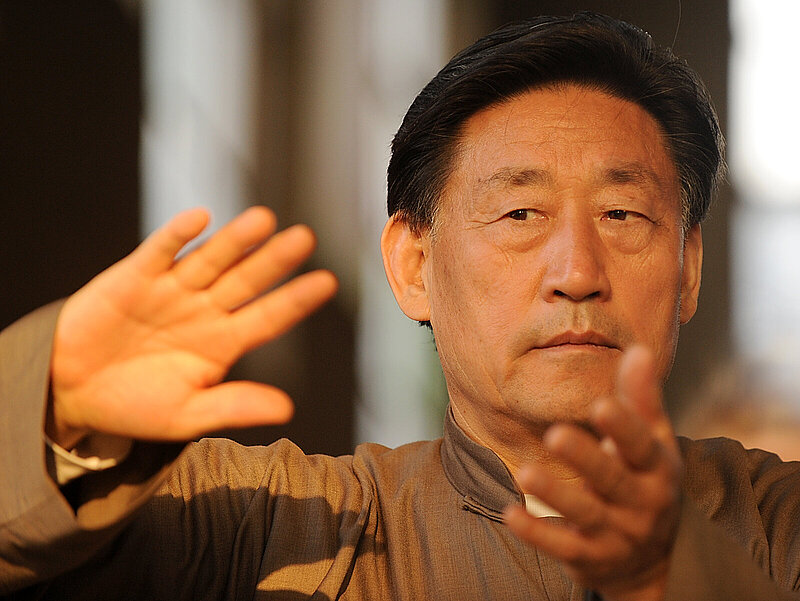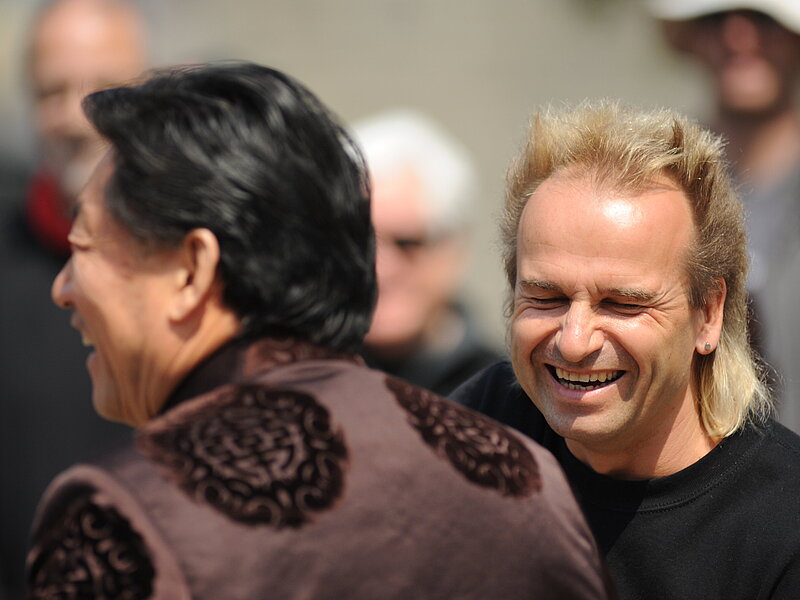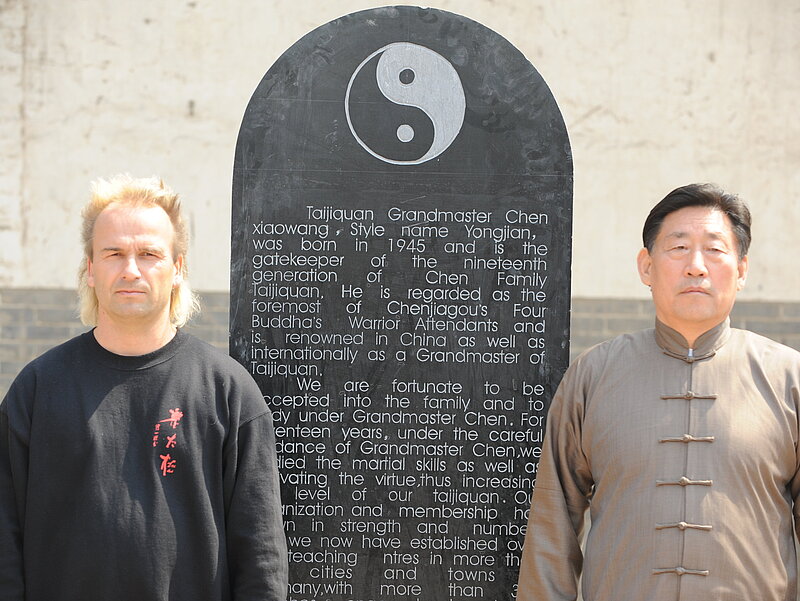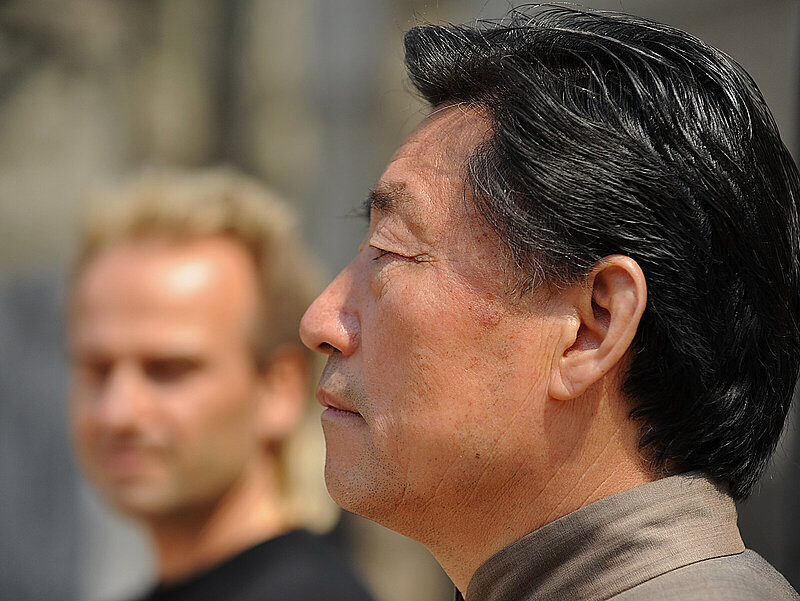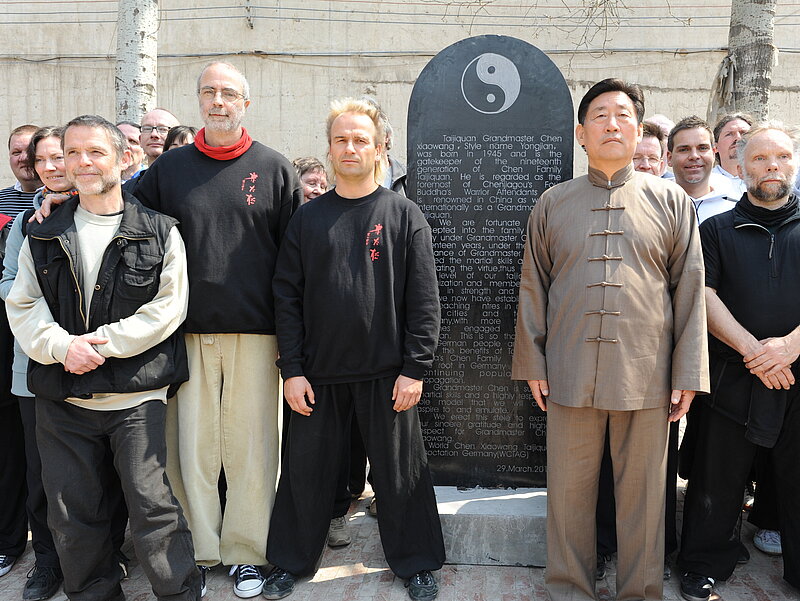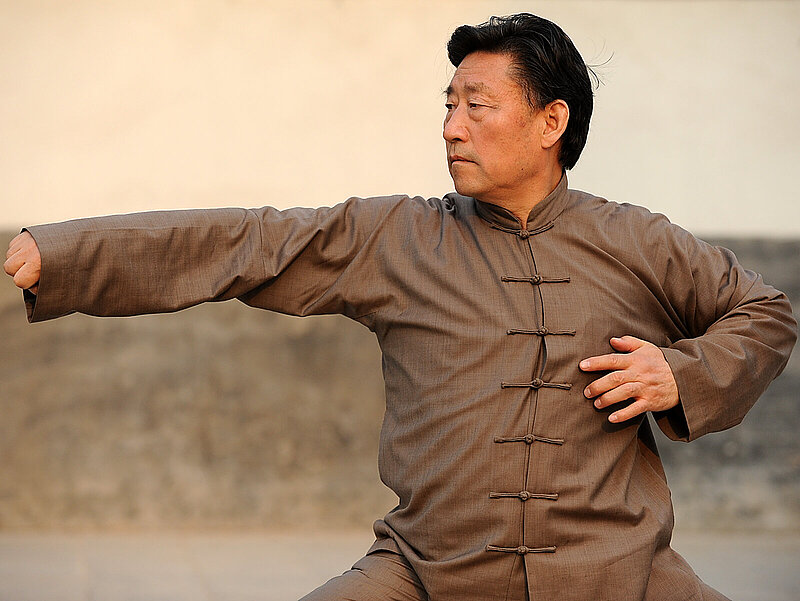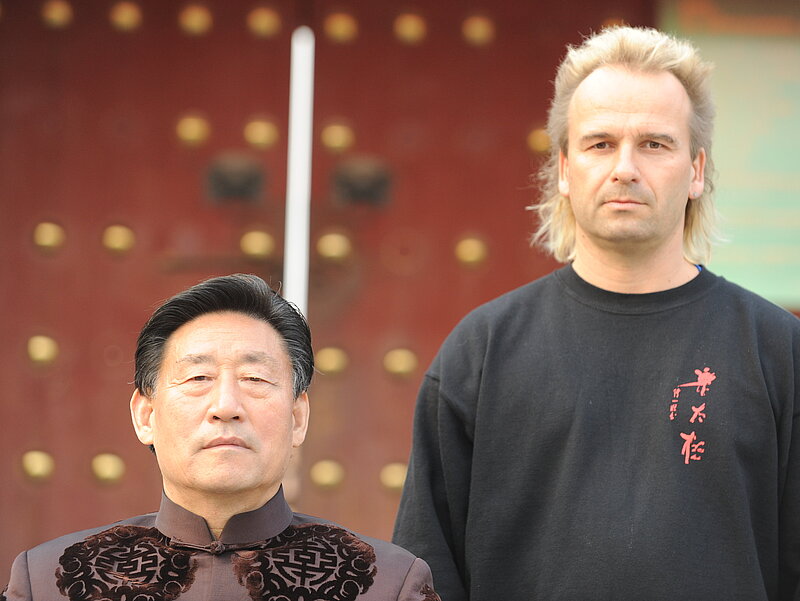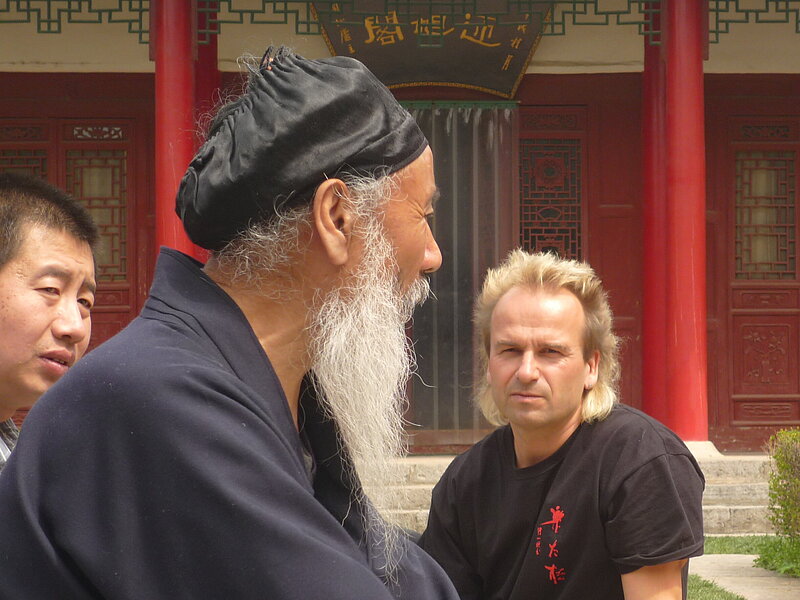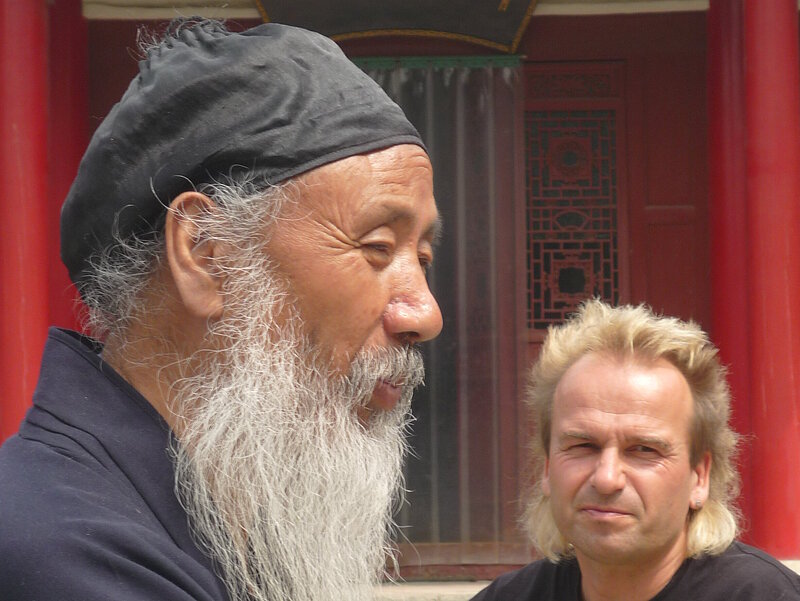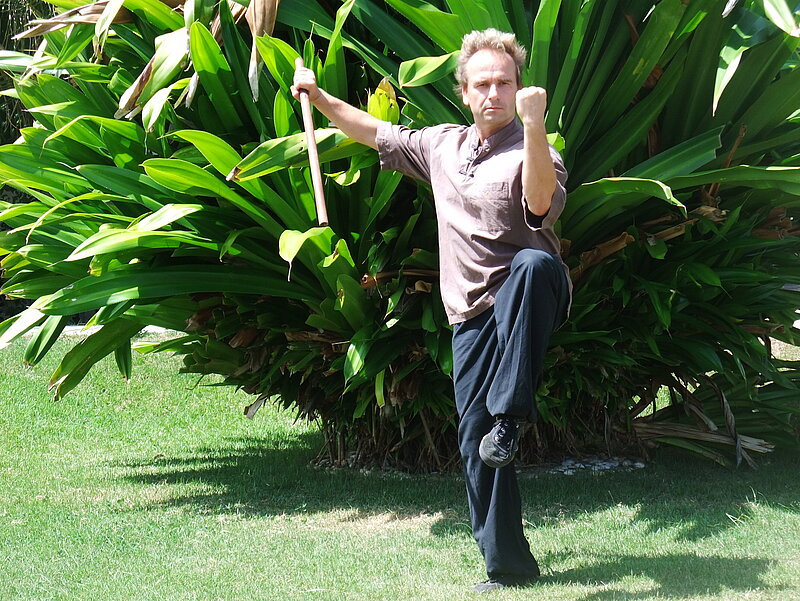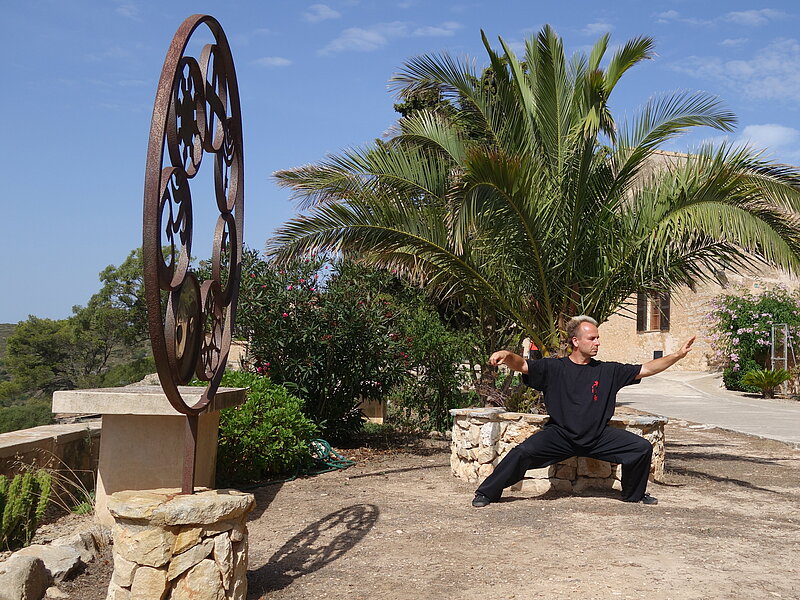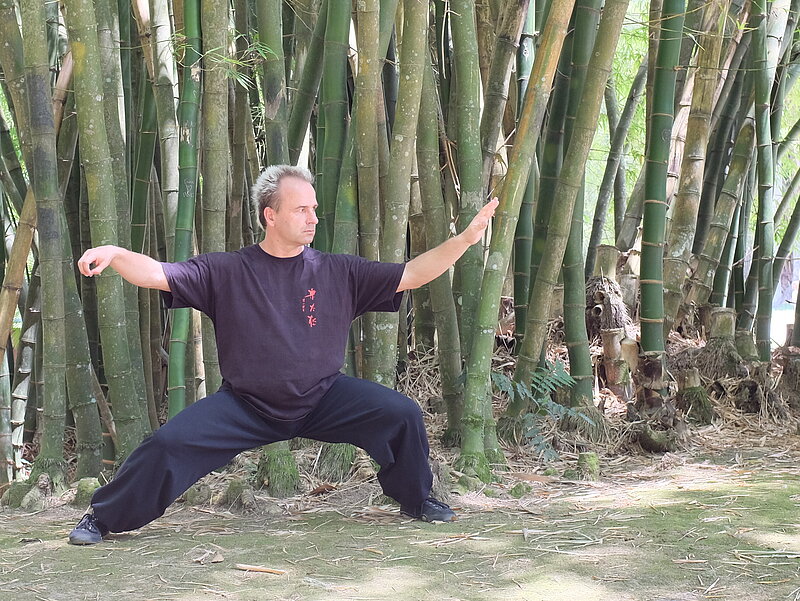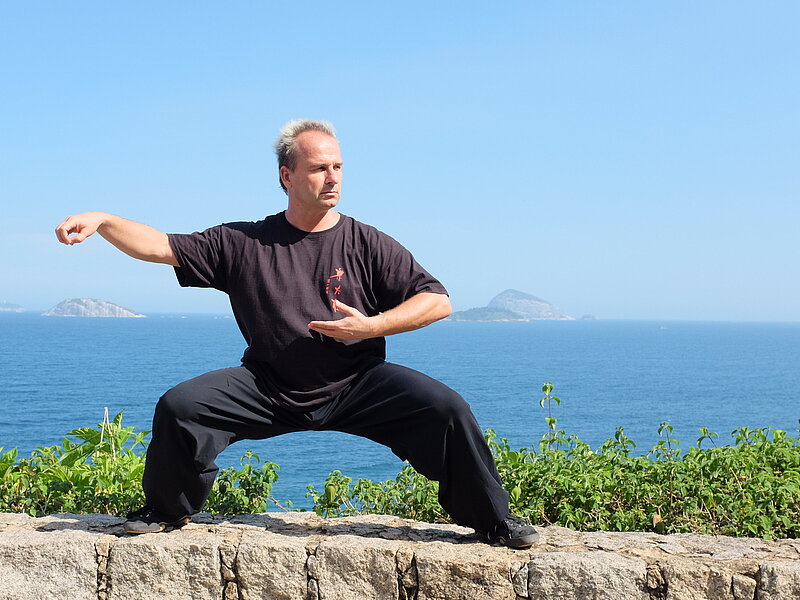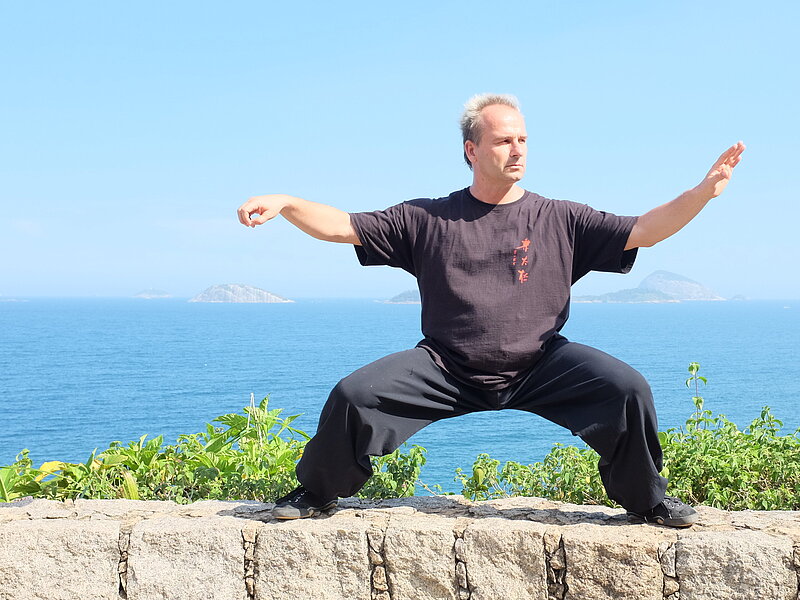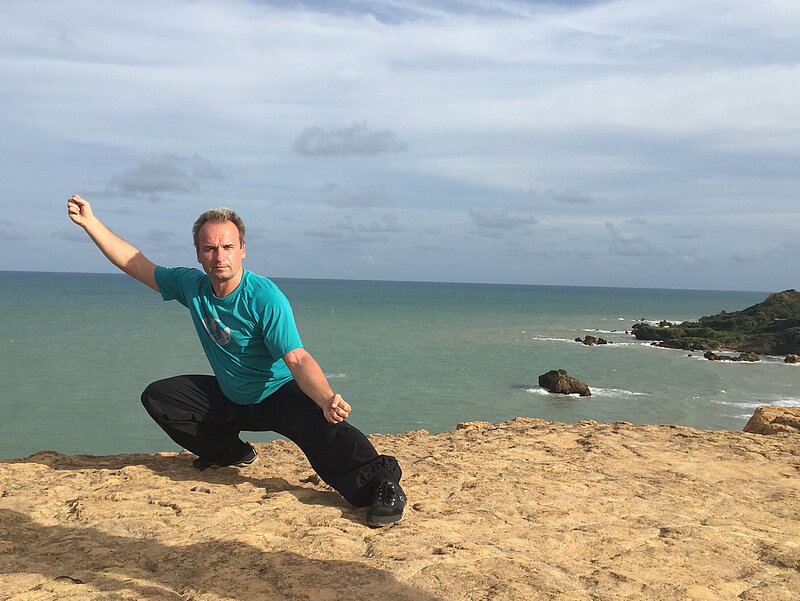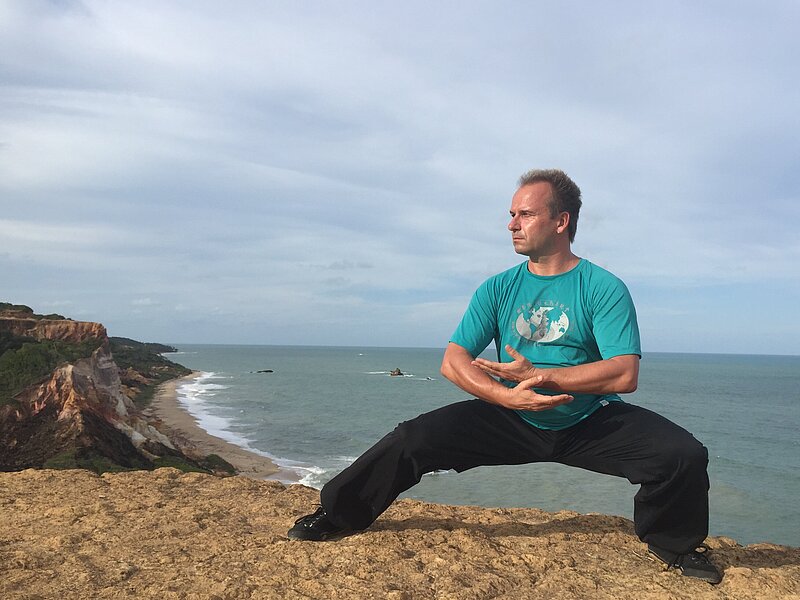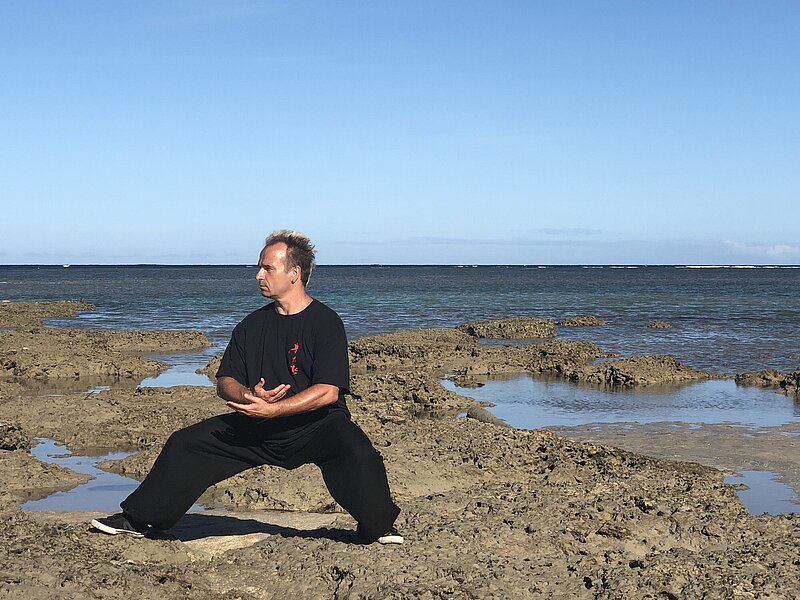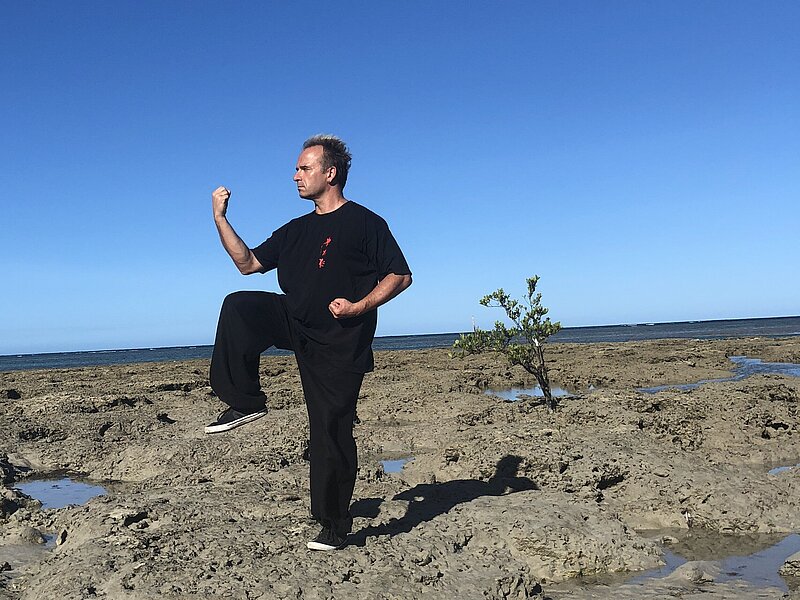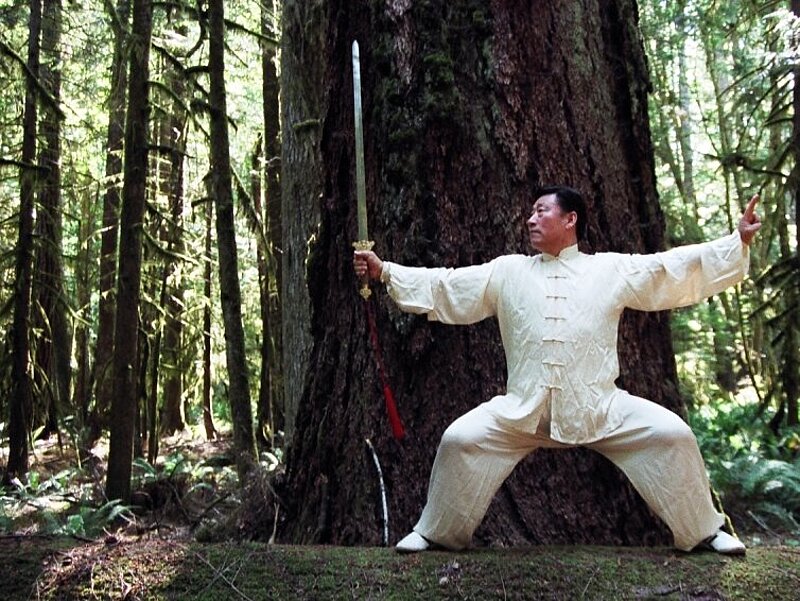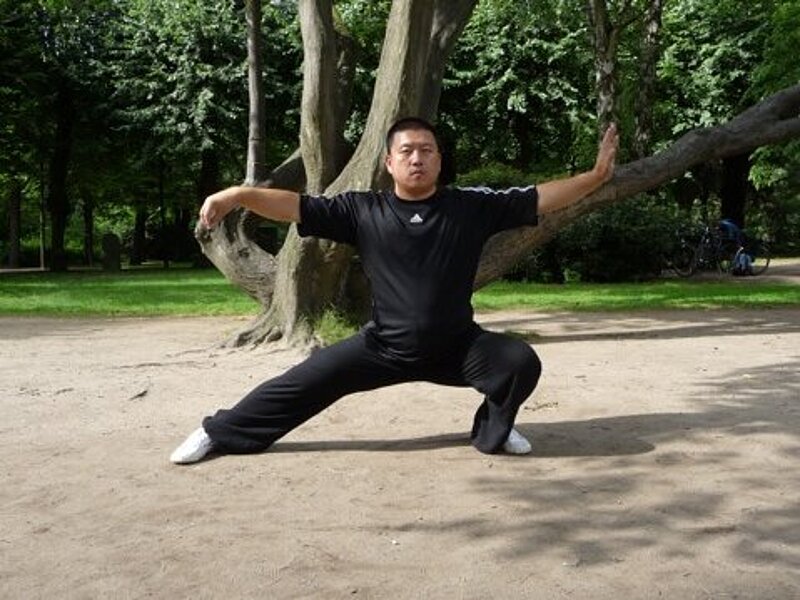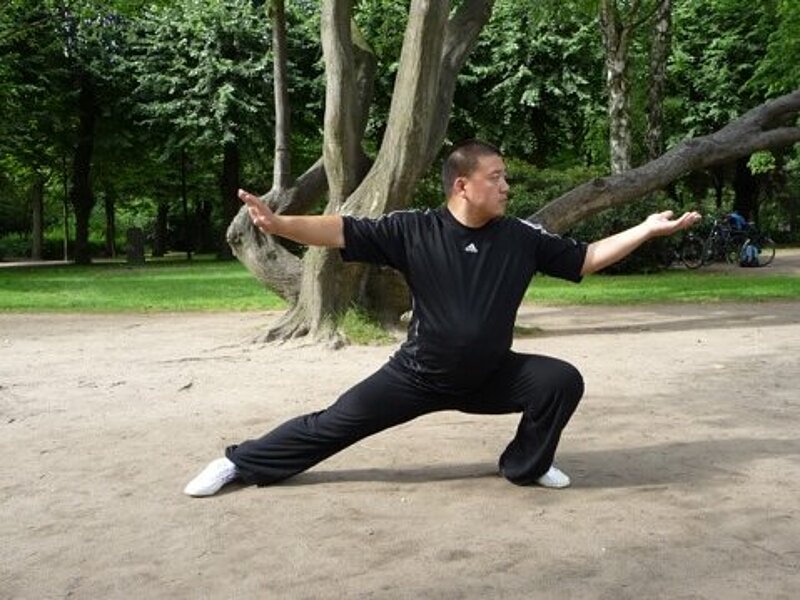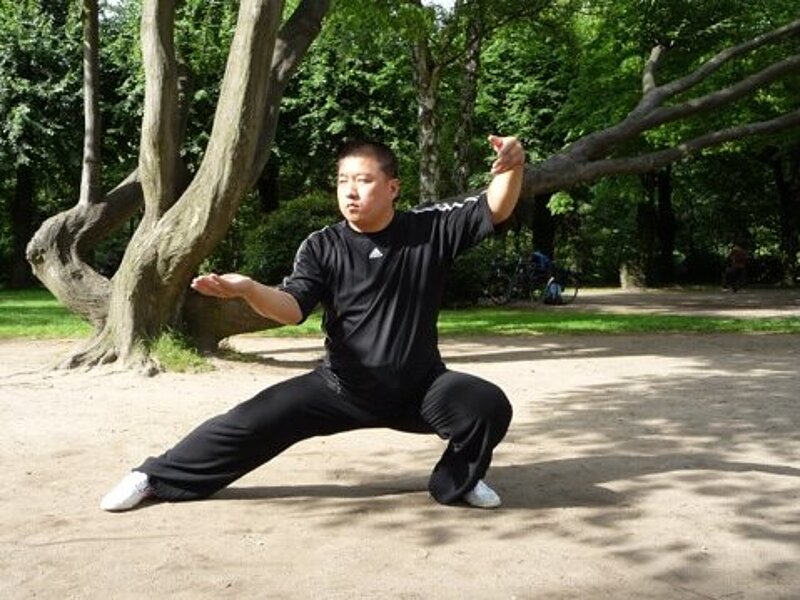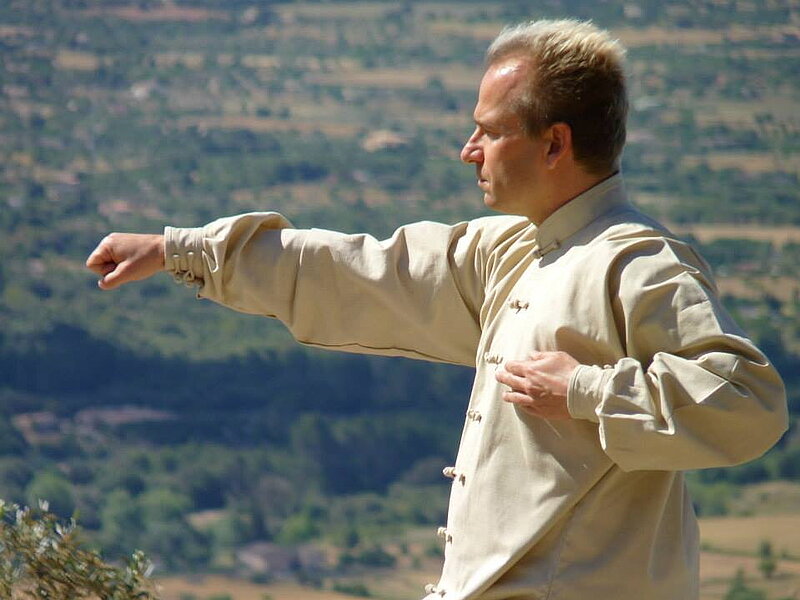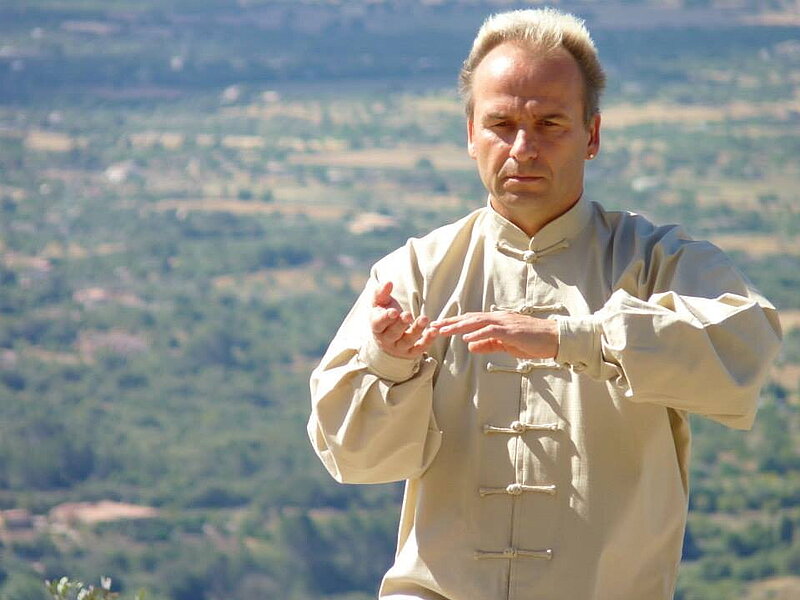Sasa Krauter in Interview with Jan Silberstorff
Taijiquan as a spiritual path

Sasa Krauter: Why do you do Taijiquan so intensively yourself, or in other words: What is your goal?
Jan Silberstorff: I started to get seriously and intensively involved with alcohol when I was eleven. That was great: going to parties and having fun. You had the feeling that life was happening here and now. I wouldn't exactly call that a spiritual quality (laughs), but you had this feeling that everything that was future didn't matter, and that growing old wasn't good anyway, because all you had to do was work. Of course, we did an incredible amount of overexploitation, but we did this with the clear realization: I can overexploit quietly, because I don't want to grow old anyway. I wasn't impressed by what I saw in my parents' generation back then. I didn't want to become like that. So I didn't have to become that old either. When I was 18, however, another point came somewhere. I remember sitting on the toilet and suddenly it struck me that the older I get, the more I can learn. And by learning, at that time, I didn't mean accumulating knowledge, but understanding. Life itself, that is, wisdom. And suddenly I had the impression that I must grow old after all in order to understand what this is all about. Shortly after that, I discovered Taiji by chance. That then didn't let me go. I had the impression that this is the medium with which I can answer my questions, with which I can continue to grow throughout my life and come closer and closer to this knowledge, this wisdom. Although that was crucial from the beginning, superficially, of course, martial arts was always particularly important. When we were drunk and fighting with other groups, we usually lost. That's why we were looking for a better way. That is, when I went to training, for a long time the goal was really martial arts. The fact that this was now Taijiquan, which for a layman at first had nothing at all to do with fighting, was due to this starting point. For the first ten years, it was really martial arts that was the goal for me - also with the challenge of showing people that what actually doesn't seem to work for fighting, namely Taiji, does work. Within ten years, we also clarified this in the German martial arts scene and made quite a good name for ourselves. Then the real thing emerged again: the philosophical, spiritual and for me now also religious level of the story.
Sasa Krauter: In the past, when you were more interested in martial arts, did you train differently than today, when you are more interested in "the spiritual"? Does the methodology, the approach change depending on the personal goal?
Jan Silberstorff: Not really. What I don't care about as much today as I used to is the sporting orientation: tournaments, competitions. Participating myself is not possible anyway, because my students take part in the tournaments. And as a teacher competing against the students at a tournament is somehow unfair. But maybe that's where the interest has waned a bit. Maybe it would have anyway. I'm 43 now, so the athletic interest is not as great at 43 as it was at 25. That's not because of my greater spiritual interest, I think rather that the spiritual interest was my starting point anyway. I also believe that through progress in Taiji, and actually in any martial art, the spiritual inevitably takes over in people who seriously get better and really go deeper with their art. And through that, of course, the martial art becomes decisively better afterwards. Because the spirit is the decisive side of martial arts - always.
Sasa Krauter: In one of your articles in the Pushhands book at the very end you write that one should always train the form in such a way that its simple and direct combat application becomes apparent.
Jan Silberstorff: As the Grandmaster wrote in the 5-level book I commented on, before the fourth level, when we run a form, we should not mentally deal with applications. When we run a form, we should focus on the Wai San He and, if that is clear so far, on the Nei San He, which then includes all the energy work, and not on the fighting technique. No matter what you're training for. I wouldn't say my training has changed. The training is always the same. But the more depth you get, the more important the mind becomes. And so it becomes more and more interesting for you.
Sasa Krauter: One hears again and again that in the Chen style, or under Chen Xiaowang, it is emphasized that it is important to repeat the forms a lot. My experience is that it is also exhausting to train so much and so hard. After a certain age anyway.
Jan Silberstorff: You have to ask how you run the form. It depends on what you mean by "train hard". We do, if you want to divide it up like that, even though I'm not a friend of it, an inner martial art. However, many succumb to the temptation that they need to train hard, even after years or throughout their lives. Hard in the sense of how you think of gongfu: I have to be done in the corner now, then I have trained well. It isn't. Today I run through forms from morning to night, one after the other, and in the evening I always have a guilty conscience about having practiced too little, although I did nothing else all day. This is because it is not tiring at all, because it is not exhausting. I have been doing this for 25 years now. My body and mind are used to it. That's actually the more important component: that the mind has this peace of mind, to really be able to train all day long without suddenly thinking: "I have to do something else now". You have to have the conditions and the time, of course. But the training is actually neither hard nor not hard. You just do one form after the next. You try to do the forms correctly, but you don't look for the physical effort in it. It can be physically demanding, and it is, but you don't look for the effort. And by not seeking it, your body and mind get used to it, and eventually you reach a flow of energy in your body so that it just feels good and enjoyable. And then the training is a no-brainer.
Sasa Krauter: You introduced sitting meditation into our system, at least in our association, WCTAG. Why?
Jan Silberstorff: The deeper you get, the more you are thrown back on the mind. The mind is the starting and ending point of all development. If you are interested in spirituality, the only thing that has permanence at all, if we start from impermanence and change, is finally and ultimately to be attained through the mind. We know that we are dying. Jim Morrison said so beautifully, "Nobody gets out of here alive." That means: we all die. But if you're not satisfied with that now and say, "Actually, that's not a nice idea, that we're all dying. What's the point of it all now? Why should I do anything here now if I'm going to die anyway? And from the 14 billion years of universe history I can live at the most 70, 80, 90, 100 years. I don't appear at all, so to speak. That can seem a little depressing. If one asks then: Is there not somehow something after death? Or: Where was I before birth? When you deal with these questions, you're always just thrown back on the mind. Because the body definitely decays and in the spirit there is accordingly that which then carries you on, to put it simply.
Sasa Krauter: I spontaneously remember what Zheng Manqing said when asked why he does Taiji. He said: "We grow older and wiser anyway. If everything goes well, the mind develops anyway, but the body deteriorates with age. He practiced Taiji in order to enjoy the benefits of this mental development as long as possible with a healthy body. So just the other way around. I also think that it's a great advantage of our system that we can maintain physical health in order to work with the mind.
Jan Silberstorff: Exactly, that's the important thing: the length of life gives me the opportunity to develop my mind. I don't know what will happen afterwards. I only know that I can do it now. So I make use of it now. And that's why the spirit is the decisive thing. The body, in turn, carries the spirit, so the body also has to be kept healthy so that I can work with the spirit for a long time. If it is about the spirit - because within the spirit afterwards the level is to be reached, which is removed from transformation or is not dependent on transformation - then of course I also need something where I work directly with the spirit. I do that in the Taiji forms, I do that in the Standing Column, I do that in the silk exercises. But it's good to also have an exercise where I deal exclusively with the mind, and that's the sitting meditation. This has always been part of the Chen system. I didn't introduce it new; it's always been there. Chen Xiaowang meditates, the other grandmasters meditate too. It just doesn't play such a big role outwardly, it's not taught that often. I learned different meditation techniques in Chenjiagou. There is no single sitting meditation, everyone does it a little bit in their own way. The background of Taiji is Daoist-Confucian-Buddhist, these three religions together. And so is meditation: one does it a little bit like this, the other a little bit more like this. I learned the techniques and then practiced them very intensively for a few years. Later, I had the opportunity to deepen this much more, because a monk invited me to do my meditation intensively at his hermitage in Sri Lanka, and helped me in a wonderful way. Although it was a Buddhist Therevada monk, it was not about doing Buddhist meditation; rather, he helped me with my Taiji meditation. He's incredibly advanced in his practice, so he was able to relate to me extremely well. And then I did my retreat there for ten years, every January for 28 days in Sri Lanka, with his company, and brought Taiji meditation to a completely different depth. Or, to put it modestly, he brought me there. I then developed this Taiji meditation after those ten years, almost twenty years in total. Because it was a lot of different exercises, I stripped it a little bit of superfluous things for our purposes. What I did without may be very useful for others in other contexts, but for what we are doing, we don't need all this. I worked out and put together three specific stories, demonstrated them to the Grand Master, talked them through with him, got his permission to teach them, and then introduced them. First in Germany and now gradually in the other countries.
Sasa Krauter: That's very interesting to hear the story about these three stages. The first stage, for example, is recommended especially for developing a Dantian feeling, I would say.
Jan Silberstorff: Exactly.
Sasa Krauter: Many people who are familiar with Taijiquan say that this is what is often missing, the Dantian feeling and subsequently the moving out of the Dantian.
Jan Silberstorff: I can clearly say from my experience that I gained my Dantian feeling for the first time and mainly from this meditation.
Sasa Krauter: Me too. But then of course I ask myself: Why is this not possible through Taijiquan? What was going on there all these years?
Jan Silberstorff: Well, first of all, both are Taiji and both are Chen style. I have not invented anything new. I have only emphasized one aspect, which is not so widely perceived on the outside. Of course, it is also about the forms and the Standing Pillar. However, it is easier via the meditation, or rather its first stage, because - apart from becoming calm - it exclusively serves this goal. This exercise is especially for that.
Sasa Krauter: If I try to analyze this, I would say: The first two stages of sitting meditation are good above all for concentration training, as well as for finding calmness. The second stage is again explicitly good for one-pointedness. And the third would be a so-called formless meditation. This has no object in the sense of Dantian or Mantra. And there lies the difficulty. In zazen, for example, the breath is counted, so you quickly notice whether you are still there or not. In the third stage, the formless meditation, it is extremely difficult: Am I still attentive, am I still correct, or am I just drifting off into some dream world?
Jan Silberstorff: Exactly. That's why the first and second stages have to be very well developed. That's why we have our quite rigorous requirements for people who want to do this seriously: Before they start with the third stage, they have to develop a certain foundation first. And if I get lost in the third stage, I just go back to the second and start again from there. It's like me going into the forest. I was walking through the bush in Brazil the other day and unfortunately I didn't have a "tether" with me, but I was afraid of getting lost. I always remembered a certain route, very consciously: this tree, that tree. And when I noticed that I was no longer on the right track, I always went back to the starting point and then set off again from there.
Sasa Krauter: It's good when you realize that you've lost yourself. But what happens until you realize it?
Jan Silberstorff: Losing oneself is also the goal of the third stage, but in a "correct way". But the third stage is of course also there for the highest goal.
Sasa Krauter: I personally find that difficult, too. I think in the third stage it's easiest to really fool yourself. Do you understand?
Jan Silberstorff: Not quite. You can do that with the second one just as well. And with the first one, too, actually. To develop the third stage properly, you need a good teacher - much more than with the first and with the second stage - and you should do something like retreats. Because for the third stage you need a totally different intensity. But if you have good guidance, good opportunities, and a good foundation (through the first and second stages), you can distinguish path from deviation there, too.
Sasa Krauter: I told you years ago that I now feel that I have meditated myself up to quite a good "wellness level", that everything is good, that I am better, that my surroundings are better with me and so on. Now I could also stop, but something also makes me dissatisfied, because I think that can't be it. That's when you recommended that I go even more into silence. Because we didn't have this infrastructure in our association for retreats to Sri Lanka, which is only possible for men, and I also didn't want to fly halfway around the world to sit alone on a mountain, I came across zazen. There are teachers, spiritual guides, seminar houses and retreats.
Jan Silberstorff: That's an infrastructure I'm tinkering with all the time. That's why we made the monastery in Sri Lanka available. As mentioned, only men were allowed to go there because of the Buddhist structures and specifications of the temple, which we sort of incorporated into our association. I can't change that, but I have made other places available: in Brazil, in Hamburg and on Mallorca. I also teach these weeks of silence myself. Now I also offer them for 14 days to prepare people to get into such retreats, so that they can do them themselves. There are enough places, also monasteries in Germany, that offer the possibility to do your own program. But it is definitely important for such a retreat that you know how to go into such a thing, how to secure the retreat from the outside, so that you are not disturbed, and how to protect yourself from smuggling in a little book or something. And above all, how to get out of it well again.
Sasa Krauter: Something completely different. Can you please try to describe to me how the dantian or the dantian movement or rotation feels to you? I feel like we still quite often confuse that with a hip movement, with such a big, more physical story.
Jan Silberstorff: It's not a confusion, that's right. It's just a little bit more gross. It's like in physics, where you try to get to smaller and smaller particles. In the beginning you have a stone like this in your hand and say: Okay, I haven't found a smaller stone yet. Maybe this is the smallest one. Then at some point you get it chopped up and so on. That is, you come more and more to the center, that is, to a smaller and smaller unit. And that's exactly how it is in the beginning, when you move out of the hip, out of the whole area. That's completely right. Then you have to get a little finer. Isn't there a smaller unit that I can move out of, and another smaller one, and another smaller one. As for the Dantian, I don't want to be too prescriptive about that, because I don't know how it feels to others. There are theories that everyone sees the color red in their own way. It is a condensation of what we call energy. One would actually have to explain this concept of energy again. What actually is energy, and what do we imagine it to be? I used to imagine something like in "Star Wars." Lasers radiating in the body, whizzing around or something. However, that's not what it is at all. To put it simply, it's a condensed feeling in the Dantian. Something where something immaterial is condensed, but that from the point that you can actually also move, over which you can actually also set up the body. So it's definitely a perception, not an imagination or a conceit, but a perception. I recently had to clear up another misunderstanding with someone who has trained with us for years: It's just not a bullet or anything. It doesn't have a boundary. It condenses more, towards the center.
Sasa Krauter: From my history, I can perhaps describe the development like this: At first I only imagined the Dantian, and I imagined it roughly like a cross, a point on the outside of my belly. But I only realized that I had imagined it that way on the outside when it was no longer like that ... during the first stage of sitting meditation. Then it slipped more inward, under the skin from the inside. Then even further inward. And then from there into the whole body and from there even, if I want, beyond.
Jan Silberstorff: That sounds quite reasonable, for example. I wouldn't have described it that way, but it sounds absolutely reasonable. There's just a feeling of compression, a pleasant feeling. It can also be warm, but it doesn't have to be. I don't think it's warm for most people. And you have to get the connection, from that condensed feeling to the body.
Sasa Krauter: In the whole body?
Jan Silberstorff: Yes. Dantian as the center of the whole body. The most dense center. This very universal image, I really mean the universe now, this universal image of a galaxy where there's a center point from which the vapors come off. That's kind of what that is.
Sasa Krauter: And in that context, how is the phrase to be understood "The movement starts in the Dantian, but the root of the movement is in the feet or in the earth"?
Jan Silberstorff: One is energetic, the other is physical.
Sasa Krauter: Is it also that, when you say "everything one after the other and yet simultaneously"?
Jan Silberstorff: Exactly. Energy flows from the dantian up the spine to the fingertips. I practice that slowly, in a time interval of a few seconds. So it takes time. A few seconds, perhaps. My attention then goes down this path accordingly, and the energy follows. Nevertheless, all the time the entire path is energetically closed. This also means that I can be anywhere at any moment. This means that I practice slowly, but the movement must be present immediately. In combat, for example, it has to happen terribly fast.
Sasa Krauter: That's also what you describe as "being online" in recent times. I think that's also quite good. So "alert" to the fingertips. It's not first start, first one, then two, three, four ...
Jan Silberstorff: Exactly. "Alert", there's already a bit of tension in it. "Being online," it's just like that.
Sasa Krauter: Plugs in.
Jan Silberstorff: Exactly, that's just the way it is.
Sasa Krauter: I have a student who's translating Chinese texts by Chen Zhenglei right now, he's describing yes the whole form, similar to the Chen Xin book, I think. Everything exactly, for each image of the form. He describes in great detail what part of the foot is in contact with the ground, for example, that the yongquan points are empty, as opposed to the rest of the foot. This is described in such detail as I have never encountered in our association or through you. How can I understand that?
Jan Silberstorff: Well, the way it is written there.
Sasa Krauter: Why don't we do it that way?
Jan Silberstorff: We do it like this. You just mentioned the Chen Xin book. There are two things. In the Chen Xin book, it is very detailed and therefore very complicated. And in reality, it leads to the student being completely overwhelmed. This makes it useless in a certain sense. That is, teaching it is interesting and fun, but may have no effect at all. But of course it doesn't. Now you could say that if you write something like that, then it's a bit of bragging - look what I know - but it's not useful after all. But that's not true either. I write things like that myself. Everyone buys my Push Hands book, but most people don't read it because they get stuck somewhere because it gets too complicated. And that's fine, too. And yet it has to be written and published. So Chen Xin did an incredibly good job because he published that. We have it. But what that doesn't mean is that everybody should train with this book, because then they might miss the naturalness of it. Because then it's just too complicated thinking and the naturalness doesn't develop as a result.
Sasa Krauter: One thing puzzled me about Chen Zhenglei. He describes the lifting of the arms in the picture "Buddha's Guardians" like this: He says that the inner qi first sinks into the dantian and then down the inside of the legs to yongquan, then up the outside and along dumai back up the back, then through both shoulders into the elbows to the hands. Now I would say that's just the other way around from our energy flow: up the front and down the back.
Jan Silberstorff: Two things about that: First, that's not wrong at all. Practiced in that way, that's a very good and deep qigong system. It's great. But it's still way too complicated already. With Buddha, for example, it was like this: you have 80,000 books of Buddha's teachings. It's an incredibly clear and well-described spiritual science, a religion. But finally, to really take it on, you just have to get it: The essence of things is empty, let go, and you experience it. If I read the 80,000 books, when am I going to meditate? I don't have time for that at all. Like this. It's great and right. I will still write many such things in my future, but a Chen Fake, a Yang Luchan, a Chen Changxing, a Chen Xiaowang have reached their high level without reading so many books. What our grandmaster teaches, the Wai-San-He and this Reeling-Silk principle - energy up the spine, to the fingertips and back to the dantian - these two together are enough to become as good as Chen Changxing, and are enough to achieve enlightenment. On this basis, when you have clearly understood this, you can of course deal with such stories intellectually and also physically. And then that is also tremendously valuable. But before that, it makes no sense.
Sasa Krauter: I find the "self-letting" a very good hint, but that seems to be sometimes difficult to reconcile with the search for perfection in a martial art. That also has a lot to do with control, at least on the way there. But how is that supposed to work: letting go of myself and getting better and better at doing the 19 form?
Jan Silberstorff: There is a very beautiful sentence in "Advaita": "Who actually wants enlightenment?" It's just the ego that wants to have enlightenment. Everybody says: give up ego, give up self, all these whole stories to get enlightenment. But who is driving us to have enlightenment in the first place? And there are two things you have to understand. One is: What do I actually want? Do I really want that ultimate resolution? Or, if it's really the ego that's actually seeking this enlightenment: The ego doesn't want to die at all. Then one actually wants to be something immortal, a heroine, a hero. One somehow wants something greater than before. Maybe something more permanent, maybe you don't want to be dead after death or you want to go to heaven. But to really consistently no longer occur, which in Buddhism, if you will, is the final stage, you first have to know exactly whether that's what you're actually striving for. If this is not so clear to you, then you are going towards something that you don't really want. Then, of course, you unconsciously have a counter drive against what you are actually striving for. And I don't get too far with that. Nevertheless, one does not have to be depressively disappointed in the world to want to reach this ultimate stage, because the further I get in this development, the better I actually feel. So is meditation: the deeper I get, the more pleasant it feels. My teacher said very nicely, "Why should the last stage now be the only one that is not like that". So both have to come together somewhere. Therefore, once you have to realize: Okay, on the one hand this striving for enlightenment is somewhere also an ego story: "I want this enlightenment now". On the other hand, there are also these tantric schools or whatever you call it, or Daoists, who say, "It's now the way it is, and this is the way it is." But both have to come together in reality. If I just do laissez-faire, I won't get anywhere either. If I have too much discipline, I also get nowhere. Therefore: discipline and serenity, both together are quite crucial. And I have to dissolve my ego in order to recognize these deeper levels. But it is not a matter of no longer having an ego, but in the moment of the mystical experience, the ego must not play a role, I must have let go of it in order to get behind it into the deeper levels. After this mystical experience, so to speak, I go through the world normally, and the I is what tells me "I have to eat something now!", "I have to discuss something with that now!". It's a tool. It's just not my - to put it simply - immortal being: The I is something that is composed of different parts and results from that, from my genes, from my body, from my socialization, from everything, and that also dies again. But it is there now. That the ego would be an illusion is nonsense, because it is there. And it is also very important. I just have to place it where it belongs. And there is also the mistake: We think that the ego is immortal. It just isn't. And in order to recognize that, I have to give the ego a rest now and then, it can then do something else, so that what's underneath becomes recognizable. My teacher said to this: "Look, you have to give up the ego then in order to have this experience. We only have this experience in ego-lessness (and in my terms even deeper in selflessness, after ego-lessness). But as I said, no matter how deep you fall, you don't have to be afraid at all, eventually your concentration will weaken, the meditation will weaken again, and the I will come back one hundred percent. You don't have to be afraid that it won't come back. That's the first thing that comes back, that's also welcome, and that's good."
Sasa Krauter: What does enlightenment mean to you?
Jan Silberstorff: The word enlightenment already says something like "shine". That means you're in a dark room, you can't see anything, you're constantly tripping over things, bumping into things. Then you find the light switch, flick on the light and see where something is, and you know. That's actually enlightenment: realizing how things are, why they're like that. I'll say Wuji, Taiji, Dao, De, this overall context, really not knowing, but having experienced. That's enlightenment.
Sasa Krauter: And so Taijiquan can also be a path of experience. What do you see as the future of Taijiquan? What are we doing Taijiquan for here today?
Jan Silberstorff: Taiji represents for the broad masses a health exercise, for a harmonization of their everyday life, a better ability for inner collection, which means that one does not lose oneself in normal everyday life. But not in the sense of egoism, but just through selflessness to find oneself, namely to this deeper self. And then, depending on how far one develops in it, just a path of enlightenment. And that is the future of Taiji. But: If the spiritual path in Taiji is the future of Taiji, it still remains a martial art. We already see that Taiji is a martial art, but the people who do it are not classical martial artists, but intellectuals who are afraid of fighting, who don't want to fight, who abhor violence and actually want to work with the mind, but use the body as a medium in the sense of Taiji. And that is also correct.
Sasa Krauter: At least here in Germany.
Jan Silberstorff: Exactly. With us in Germany and generally also in the West, outside China. But in China also more and more. And still the martial arts will not be lost because of that, because the martial arts give us the root of our art. When it comes to, to use Buddha's words, breaking out of the cycle, to strive for a self-dissolution, that is, a no-more-rebirth, then I can turn away from everything, can let go of everything and sit down in a lonely mountain hut. Then I don't need to deal with worldly events anymore. Questions about whether to have children or not, whether to have a relationship or not, all that is irrelevant because I simply don't want to be here anymore. Then there's also nothing big that I should worry about here, because I simply don't want to be here anymore. If I decide to leave Germany and go to Brazil, then I only have to worry about how to get to Brazil now. But not, what do I still have to do here when I'm in Brazil, which is nothing. But I don't think that's the goal of most people. Not yet, maybe. Then, when they reach a higher level, maybe they want to go further. Actually, it's about living a life in harmony, in bliss, actually it's more about Adam and Eve, I almost said now, before the apple bite. So actually wanting to live in a paradise. To lead a fulfilled, perfect and happy life, with the option that this will develop accordingly after death. And for this Taiji is the medium, because through Taiji you first get your life under control, so to speak. You find balance and harmony in your actions, you don't get too stressed, you don't argue so much, you live with your people in contentment and love. You are healthy. But at the same time, through inner experience, through mysticism, you recognize the state of not-being. And also the in-between of being non-being or not-being. These three levels: Wu (the non-being), Wuyou (the non-being) and You (the being), where we are now here in this world. These three levels make up all of being, if you will. To live only in Being is somehow ego and stress and struggling. To recognize non-being as an experience is security and freedom in equal measure. And the non-being, so heavenly worlds and so on, what is in between, to experience all this together, makes a perfect life.
Sasa Krauter: That certainly fits with your personal experiences, that's your personal view. Do you think there are other tendencies within Taijiquan?
Jan Silberstorff: Yes, of course, of course. But what do you mean by tendencies? It's always a question of level of development and also age, if you will. By stage of development I don't mean that someone who only fights in Taiji at a tournament has not developed. But you may come to meditation through tournament fighting at some point. That is, tournament fighting, for example, can be an important factor in development. Meditation is an important factor in the development, the form, but also the everyday togetherness. All these stories are areas in which you grow. And by development I don't mean one is better than the other, but everything somehow builds on each other. And the further I climb up a mountain, the further I can see. When I say that the spiritual will prevail or that spirituality will become the essential goal in Taiji, this does not mean that the martial art will dissolve. Rather, martial arts will always remain an essential factor. Just like fitness and health. In Taiji, you can't separate these parts from the big picture. And gradually perceiving the big picture is the beginning of spirituality. It simply means that people learn to live a more humane - I would almost say - life. That means that they feel themselves, that they perceive themselves, that they feel the neighbor, perceive the neighbor, that they better perceive the identity with the neighbor, the commonality with the neighbor and thereby learn to live with more charity and compassion and their own cheerfulness. That is, simply to have a more beautiful life. That is the biggest target group. And that is also the beginning of spirituality.
Sasa Krauter: And that is what we want to convey as an association? Or where should the association work of WCTAG go?
Jan Silberstorff: I would be very happy about that. Like any other club that gets bigger, we deal with more people, and the more people there are, the more problems there are. Our goal is to get better and better together, but that doesn't mean that we're all just walking around in white robes and being peaceful beings and playing on a harp. There are also problems, there are egos, there are people who are also looking for power. That's what we have to work on. It's the same with every larger group; it was no different with Buddha and it's no different with Mrs. Merkel.
Sasa Krauter: Gehen wir mal davon aus, dass es sich dahin entwickelt. Ob sich dann wohl auch unsere – jetzt komme ich wieder zurück zum Anfang – unsere Methodik etwas verändert? Du sagst jetzt vielleicht eher nein. Oder auch unser Prüfungssystem? Dann werden vielleicht eher andere Sachen abgeprüft.
Jan Silberstorff: Nein, es wäre ein Fehler, wenn ich zum Beispiel jetzt, wie am Anfang des Gespräches, sage: Okay, mich selbst interessieren Turniere nicht mehr, wenn dadurch im Verband keine Möglichkeit mehr bestünde, Turniere zu machen. Ich kann jetzt nicht jemand Neues nehmen und dahin stellen, wo ich jetzt bin, und sagen: „Guck mal“. Ich muss den doch auf seine Weise diesen Weg gehen lassen. Das heißt, für ihn gehören am Anfang vielleicht Turniere mit dazu. Ich vergleiche das immer sehr gerne mit dem Aikido. Ueshiba hat als ganz kleiner Mensch angefangen, ganz große Felsbrocken hochzuheben. Das hat sehr viele Leute beeindruckt, wie so ein kleiner Mann so stark sein kann. Der hat lange Zeit auch sehr äußerlich seine japanischen Geschichten gemacht, und im Alter, auch im Verbund mit seiner eigenen Spiritualität, ist er immer energetischer geworden. Am Ende waren das nur noch ganz feine, wenn überhaupt, Bewegungen, mit denen er gearbeitet hat. Ich nenne das mal so das I-Tüpfelchen. Was heute passiert, das ist im Taiji eigentlich genau das Gleiche: Die Leute suchen nur noch dieses I-Tüpfelchen. Aber dieses I-Tüpfelchen kommt nach dem Strich und nicht vorher. Du musst zuerst diesen Weg gehen. Du musst eigentlich gucken, wie hat Ueshiba angefangen, okay, das mach ich jetzt auch, und darin natürlich den eigenen Weg finden. Aber nicht gucken, was hat er zum Schluss gemacht, sonst fehlen dir 50 Jahre Entwicklung bis dahin.
Sasa Krauter: I also see that as a problem here. Many people come to us who are in their mid-40s or mid-30s and want to start right away with the energetic or spiritual aspect of Taijiquan. But the body is no longer trained at all.
Jan Silberstorff: And it's the same with meditation. It doesn't make sense, right from the beginning, when I have no experience, to just sit down and become empty. Then I probably sit dully in front of me. Instead, I have to do a whole range of things, as you said earlier, in order to make consistent progress in the third stage and, above all, to recognize: "Am I on the right path or not? The physical training is always the essential medium in Taijiquan. Only it must be connected with the correct mental alignment, so that this becoming one can happen.
Sasa Krauter: That's why I jokingly say lately in my trai nings: since I'm more concerned with the spiritual aspect of Taijiquan, I like to fight again, so I like to do push hands again.
Jan Silberstorff: Yes, and above all the principle according to which we fight, the way we fight - is actually nothing other than a principled confrontation with problems. In other words, we learn to navigate our entire lives through it.
Sasa Krauter: By the way, I find that a very, very big advantage of Taijiquan. Basically, Taijiquan seems to me as if it immediately carries more of this everyday life test. The fact that someone "pushes" on you, for example during pushhands, makes it easier for you to carry over into everyday life.
Jan Silberstorff: That's what I mean, too. Our clientele, the target group so to speak, are also people who are spiritually interested but actually find the worldly life beautiful. They actually want to work on becoming better people, they want to grow. Whether they grow into the sky with it or even grow beyond the sky is then individually different. But actually they just want to learn to develop and become better. And that's where Taiji is so great, because it reaches beyond heaven in terms of development possibilities, but it also has an incredible amount in store for normal everyday life. It's the bridge between an ascetic monastic experience inside a mountain to the everyday problems when I'm standing at the checkout at Penny's and everything takes so long, I still have to pick up three kids now and I still have to do this and that. That is, I have about the sitting meditation with closed eyes the inner world, so to speak, I have about the stand, Reeling Silk and the forms slowly a transfer into the movement, into life, and about Pushhands on other people. Up to our everyday struggle, whereby I don't mean that so negatively, but our tasks in everyday life, on which I also grow and can prove myself.
Sasa Krauter: Yes, it is so tangible.
Jan Silberstorff: So that's soccer with a ball, not without a ball.
Sasa Krauter: You know, my goal is also that my heart opens more and more, I'll say now, that I have less fears, that I'm happy and can make others happier with it. And then I can also die better and things like that.
Jan Silberstorff: And that is the path that leads deeper and deeper, deeper and deeper, and suddenly you are a Buddha. Which you actually didn't intend to be in the beginning.
Sasa Krauter: Maybe I already am, yes (laughs).
Jan Silberstorff: Yes, that anyway.
Sasa Krauter: I've had a bit of a hard time with the connection between martial arts and the mental, spiritual path, with this conflict of "kill for love?" - that's what I've always called it. Especially with the weapon forms. I thought: I want an open heart, how does that fit together?
Jan Silberstorff: I also have the possibility to distance myself from that. We live in a Christian culture: "Turn the other cheek," I can practice that. I can, if I'm sitting in my hut in Brazil and I'm meditating and someone comes and wants to steal something from me or threaten me or wants to shoot me, then I can let go and say, "Well, then shoot me." That is, I can renounce the use of violence. And precisely because, as a teacher of mine said in a similar way, I am familiar with violence, that is, I could also survive violence, I can also assess it, can find inner peace in it and perhaps also renounce it. So I can also say, "I'm not going to fight back now." But I have the possibility. These spiritual questions are interesting, but there is just also an everyday life. In the case of a threat to those closest to me, it becomes more difficult. Of course, I can say to my family, "Gee, wife, kids, you know what, we're all going to die now." Or nasty scenario: your wife gets raped, and you're there as a man. Those are all scenarios like that, you get to the point at some point. It's not really just about pure non-violence in that sense, but it's also about self-defense, it's about the least evil. And I say, if there is someone who wants to kill five people, and I make him harmless and thus save the five, that is certainly not the very worst thing karmically. What is bad is if I kill one of them because I want to have his five wives. Then it is a drama. But if I now save five people and thereby make one harmless, then that is perhaps also justifiable. Everyone has to recognize himself in his own way. That is, it is not about the fact that a good person no longer defends himself, but about the motivation behind it, the heart, why an action happens and the control of this action above all. That it's not an anger reaction, but the control of that action, that's the crucial thing in the story.
Sasa Krauter: That's one of those points where I can imagine that some women also have a hard time: with this "martial arts as a path". But of course also men. And also with other things, for example: In the European martial arts scene, many Asian authoritarian-centralist hierarchies were simply adopted. And our western achievements, for example our understanding of democracy, are often not taken into account. Also in the methodical-didactical area often only the Asian methods were taken over.
Jan Silberstorff: Of course. Taiji will become a world art. That's what I'm mainly concerned with on the outside: How can we globalize this Chinese art, which is now becoming a world art, while preserving the Chinese root, so that we from foreign cultures can also identify with it. This also relates to our Western spirituality, to our religions, to our whole culture, with our democratization and so on, to all these things. It's a huge, complex area. There are so many different opinions, there are so many different schools, philosophical, spiritual and others. We all think Daoism is great, but Daoism was also very much criticized in China for centuries. So who is right with all these opinions? To put it simply, it doesn't matter. Clean your heart, open your heart, develop love, and everything else will come by itself. And whether or not there is a situation where you take a bit of action has nothing to do with the external action, but with the motivation from which this action arises. And if the motivation is pure and loving, then it will also show itself accordingly in the exterior. As a teacher once again said to me: Jesus also whipped people out of the temple, but would have been ready at any moment to die for these people as well. And this is a crucial point. He doesn't do it for himself, but for the people. But of course, that can be very easily misunderstood. And then suddenly crusades and so on arise, and that is certainly a very big misunderstanding.
Sasa Krauter: The area of spirituality, that is an area of partly also dubious offers. Also in the Taiji scene, I think, one must be careful.
Jan Silberstorff: Yes, totally. It's an incredibly dangerous area, you have to have an authentic teacher, you have to have an authentic lineage that you follow. And even within an authentic teaching there are sectarianism and so on, you have to keep your distance from that. And you have to practice very honestly with yourself.
Sasa Krauter: I see the advantage of Taiji in the freedom. I think Taiji is something that can set you on the path.
Jan Silberstorff: Exactly, that's what I mean.
Sasa Krauter: It can! But it doesn't have to ...
Jan Silberstorff: Everybody expresses it in his own way, and the deeper I get into this principle, the clearer I understand the connections. And then the action results correctly and not every one is equal to enlightenment, one also makes mistakes. Sometimes you overreact, sometimes you underreact. That's the crucial point, you get better with time.
Sasa Krauter: But I also see the free system as a disadvantage and that would be my last question. You know, yin and yang. Now we talked a lot about the advantages, what is the disadvantage of our system?
Jan Silberstorff: There is no disadvantage.
Sasa Krauter: Ah, come on. Jan.
Jan Silberstorff: No, there is a disadvantage only if you call the system Chen style, which is different from Yang style, which is different from Buddhism, which is different from Christianity, which is different from Daoism etc. If you say, this is my practice, this is Chenjiagou, if you leave it in that, then you have a limit. If you say, okay, this is a technique but we don't have ground fighting or we don't have this or that. Oh, gosh, we have gaps there now. But if you take Chen style, Chenjiagou, our whole culture and tradition of the Chen family, to see more clearly about that the Taiji principle - the Taiji principle is universal, it's not a system or a style or something, it's reality. And then it has no limit and no disadvantage.
Sasa Krauter: So I would describe it maybe like this: Taiji can put you on the path, but it also takes a lot of initiative to look: What do I need, what helps me to go this way.
Jan Silberstorff: Of course. There are a lot of dimensions between not-being, not-being and being. Not everyone goes directly to this wisdom, but there are perhaps still something like tasks and determinations in life. And these are individually different. And maybe it makes more sense to say, in this life I have a certain destiny, it's not about enlightenment, but I have to do something certain. And that's what I'm doing now. Everybody has to find his own way individually.
Sasa Krauter: Thank you very much for the interview.
Sasa Krauter
Dipl. Sports Pedagogue
Taijiquan and Qigong Teacher
Movement Therapist
www.sasakrauter.de

